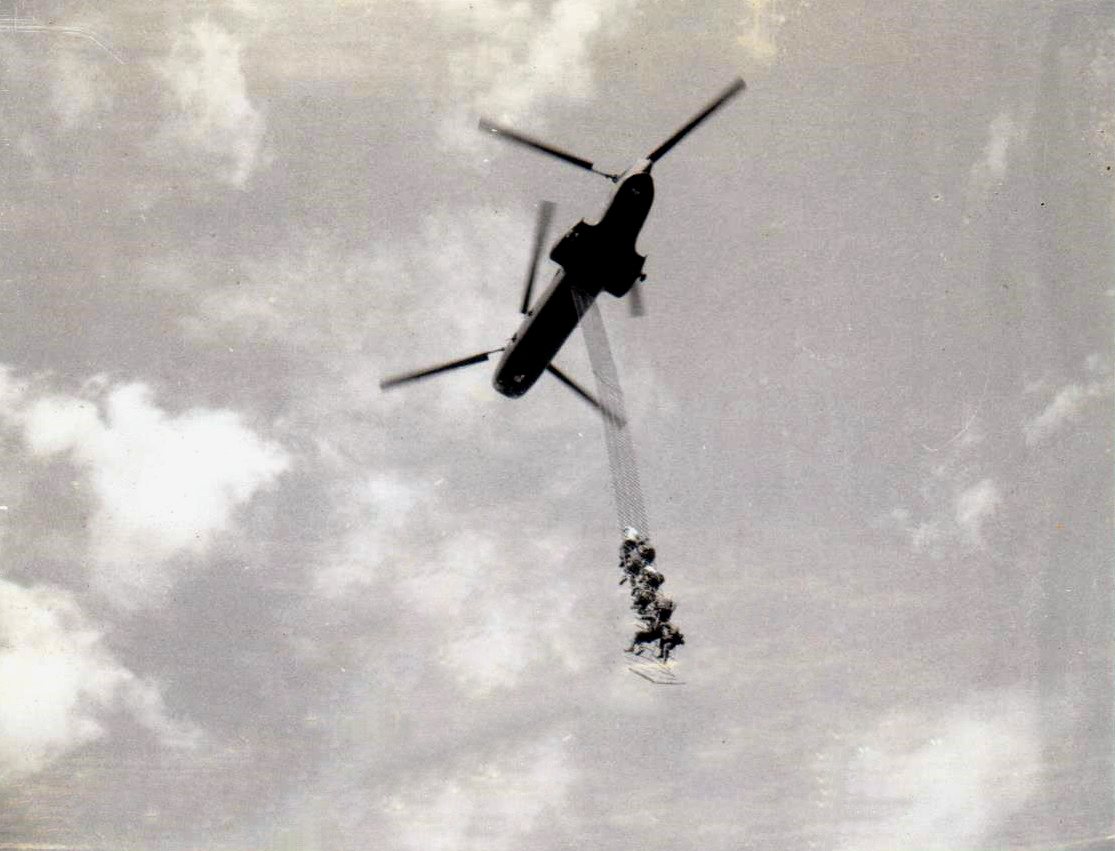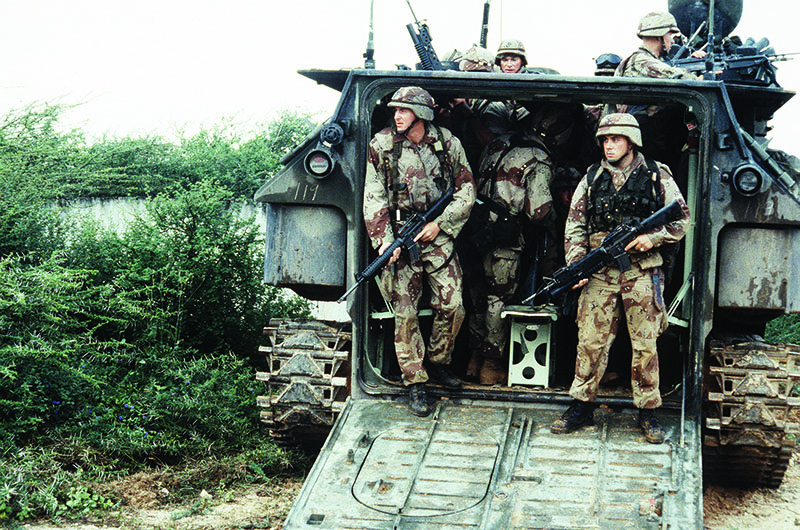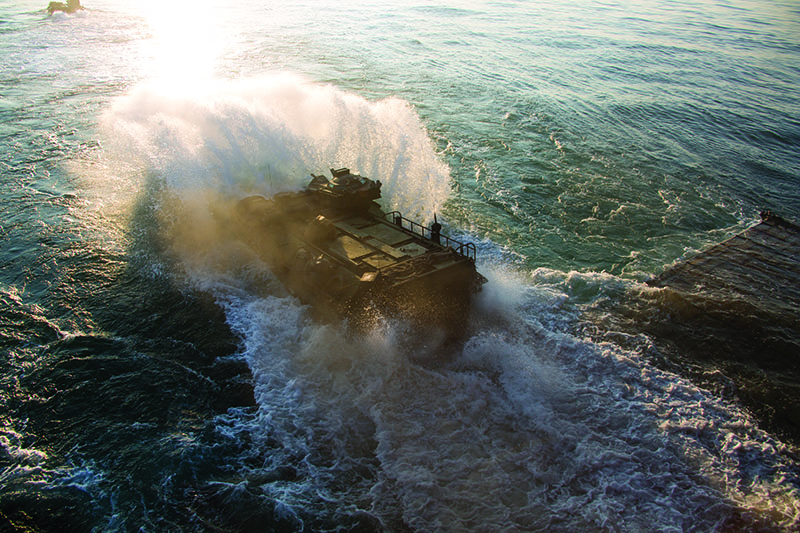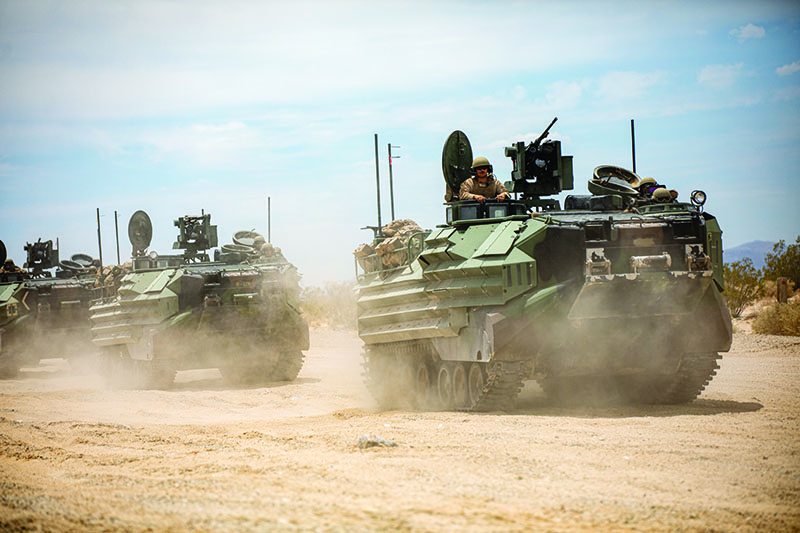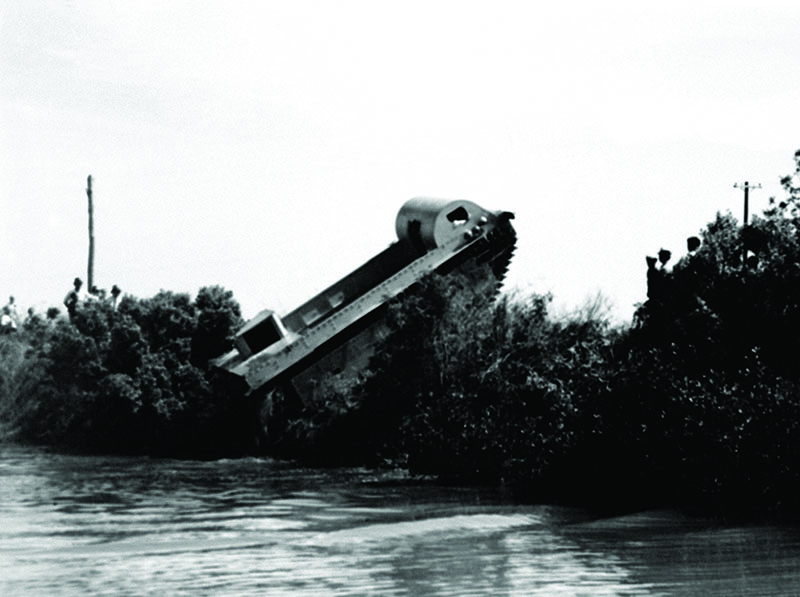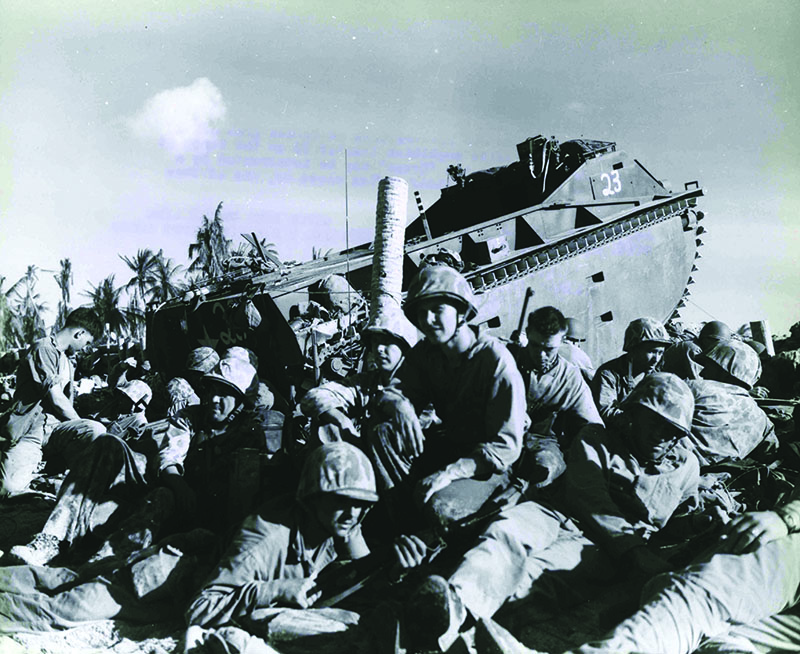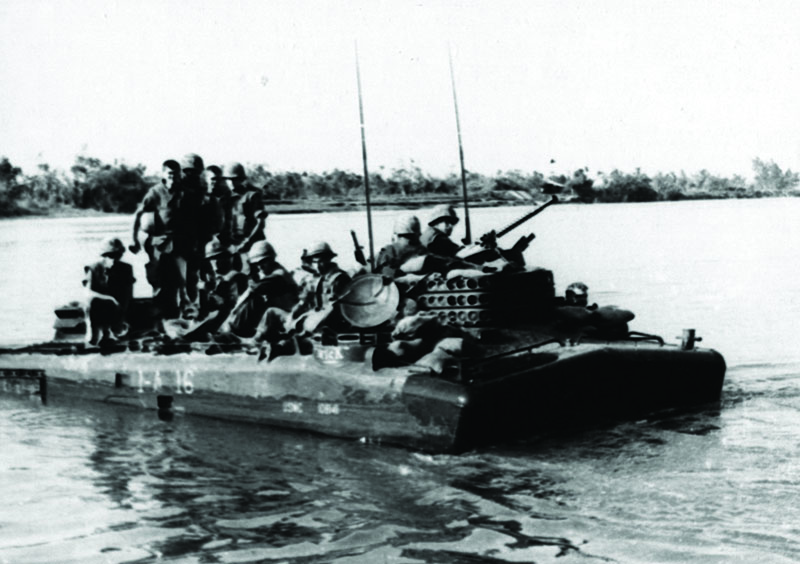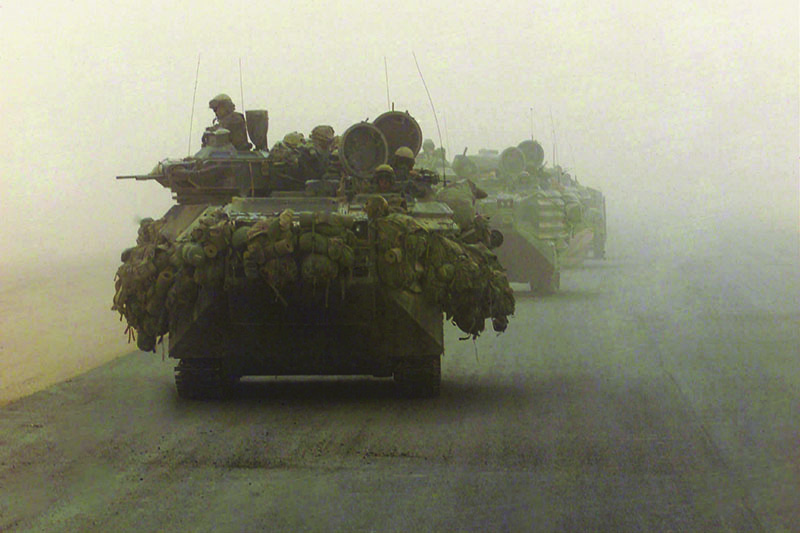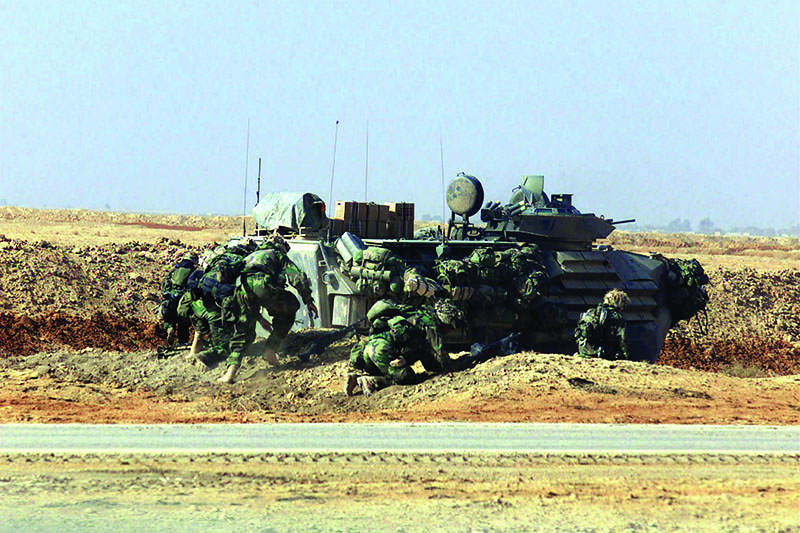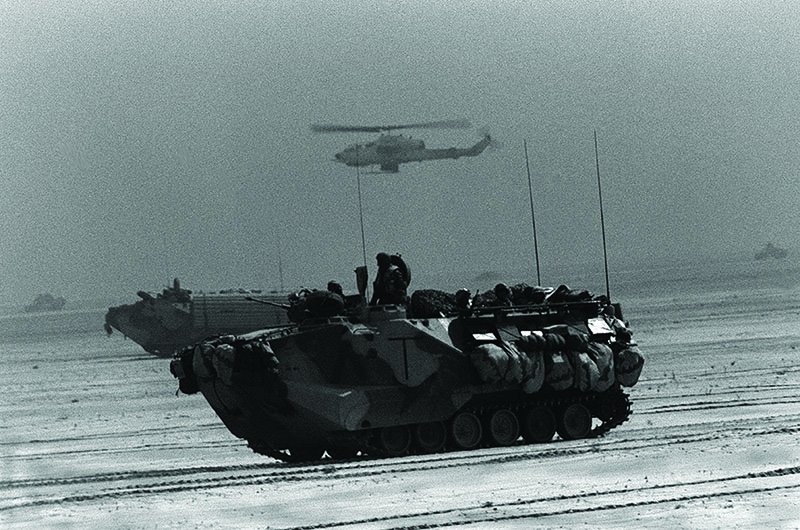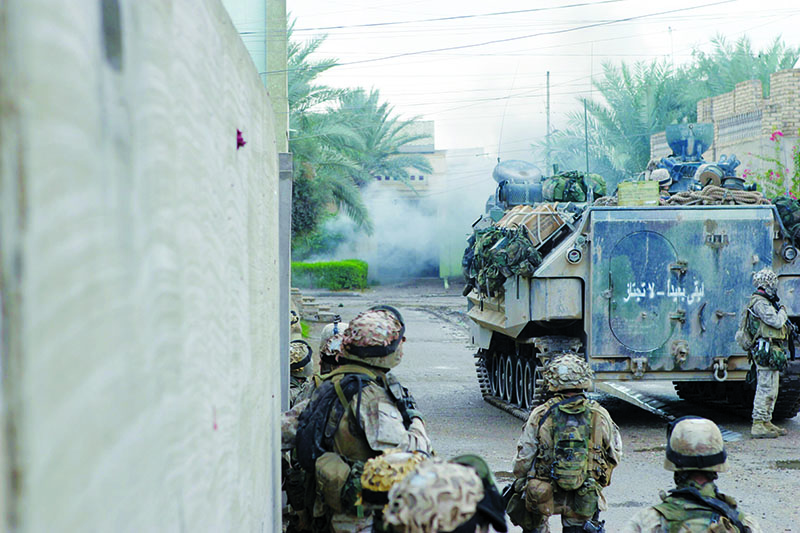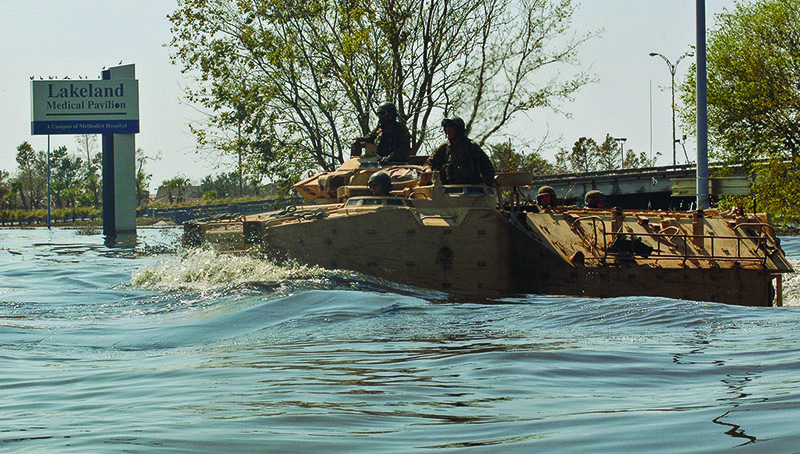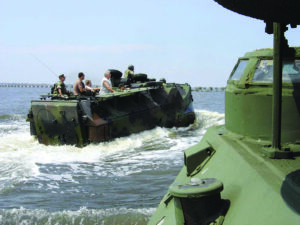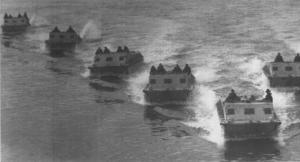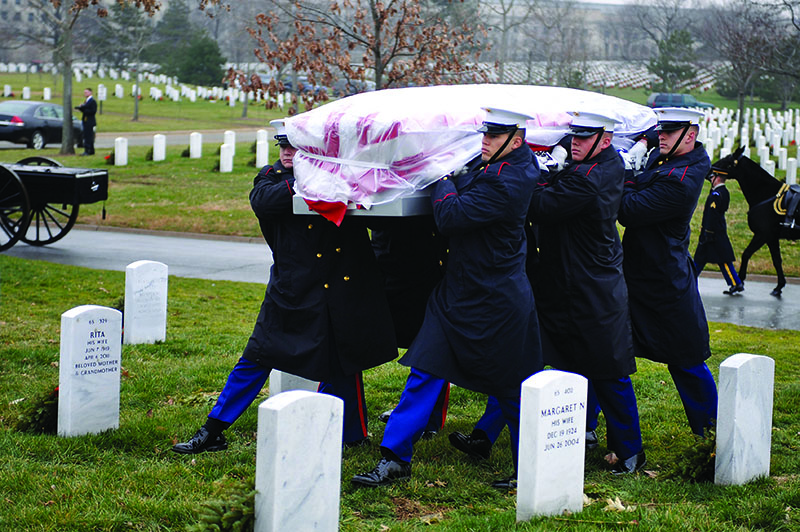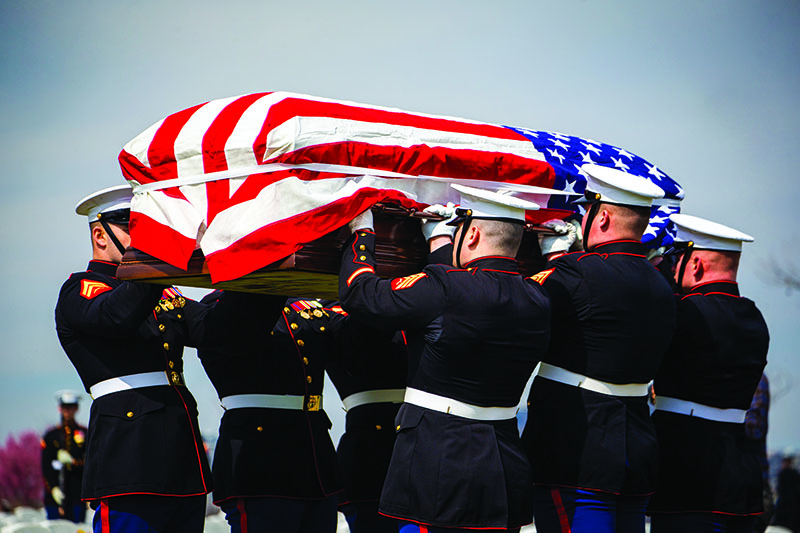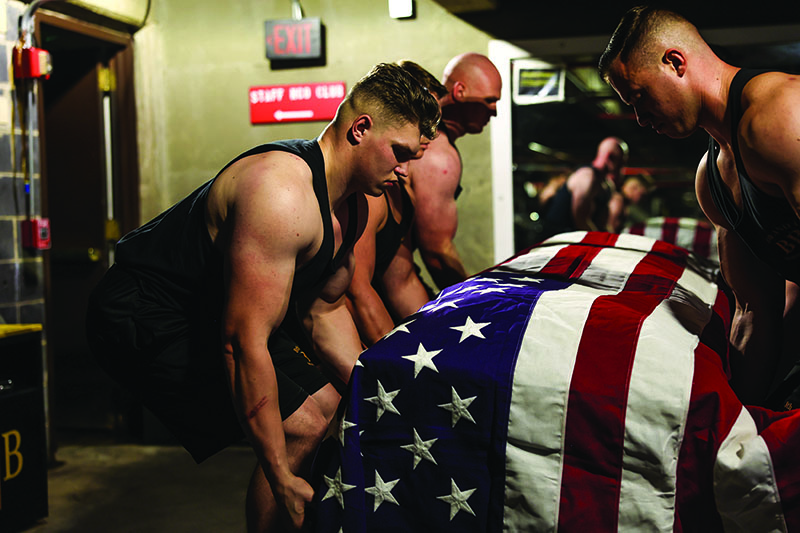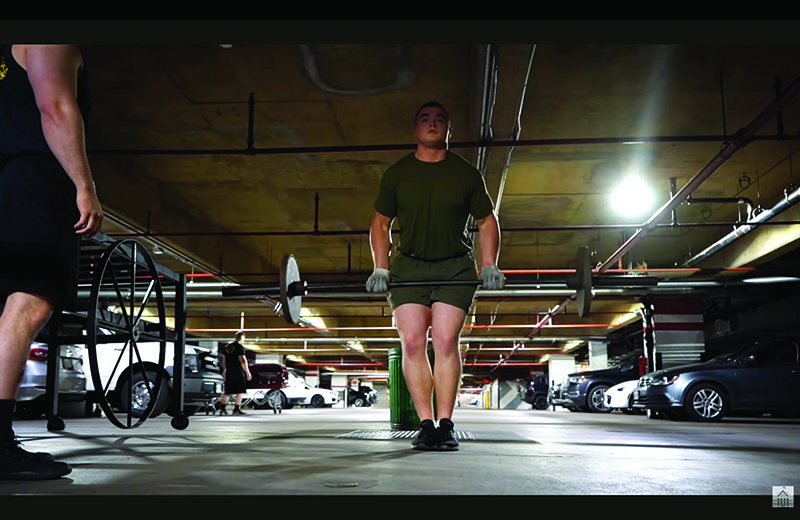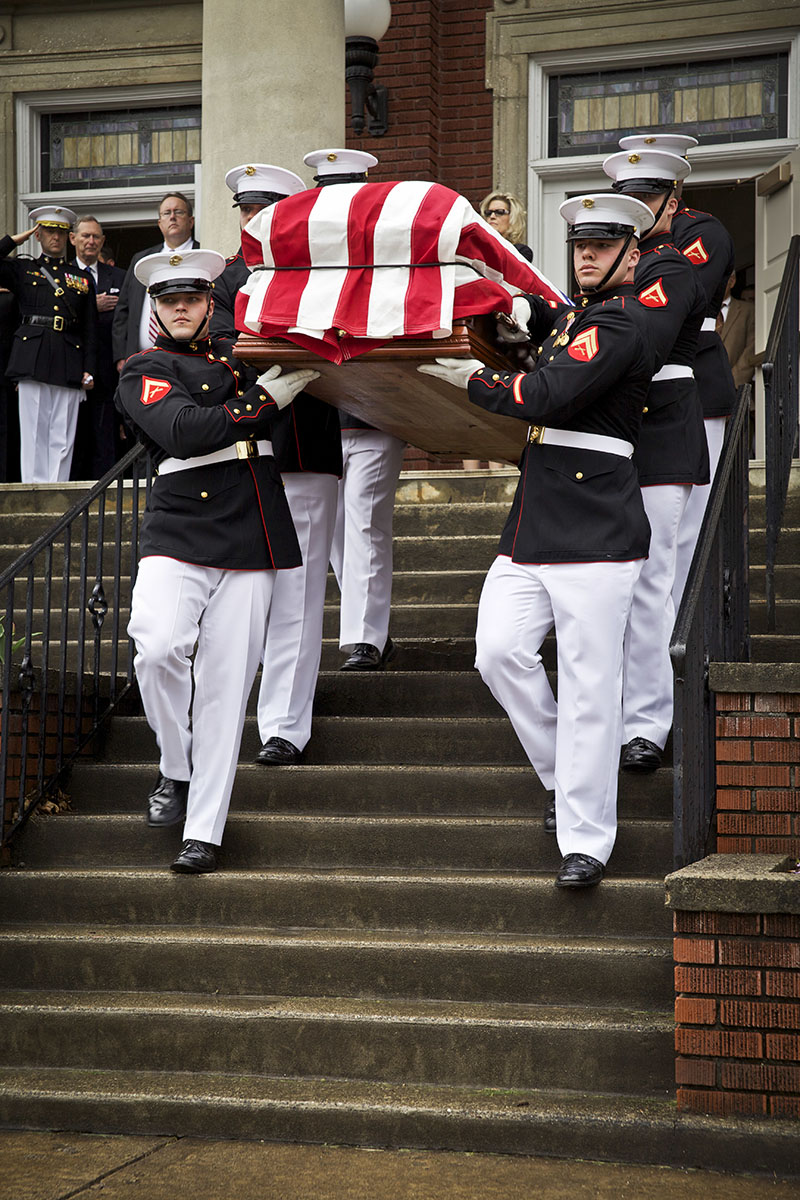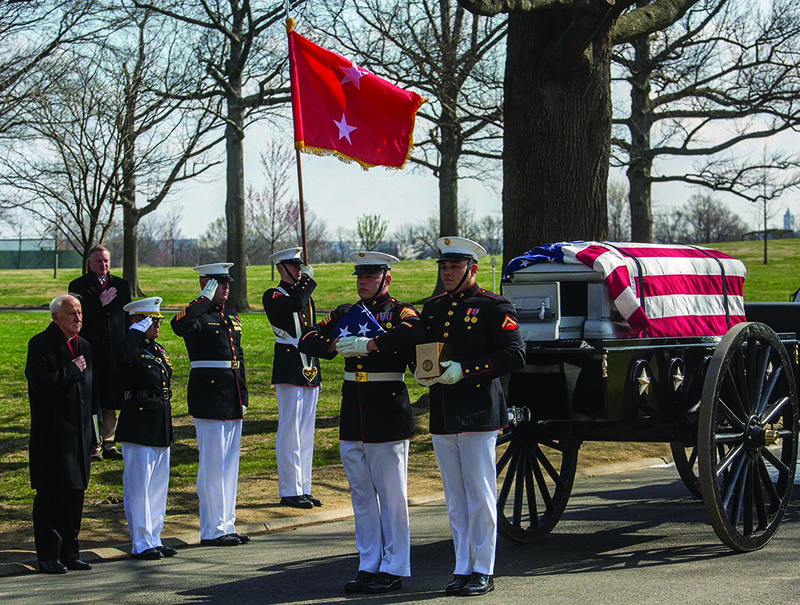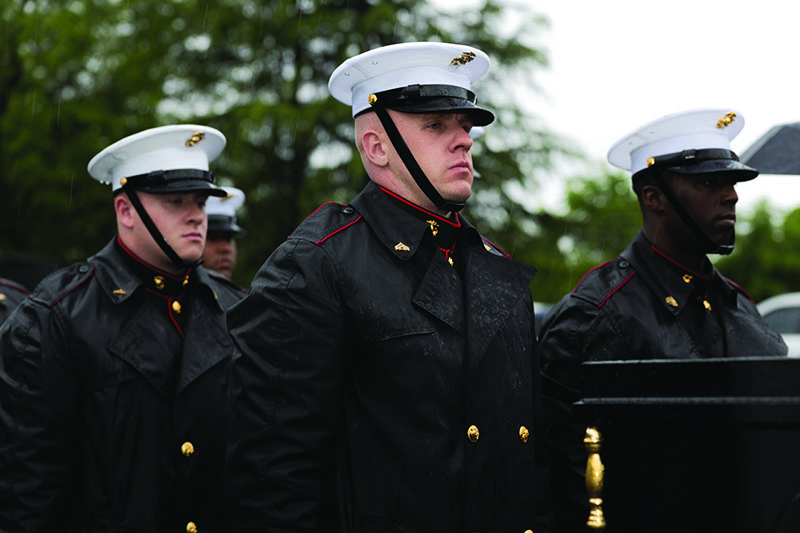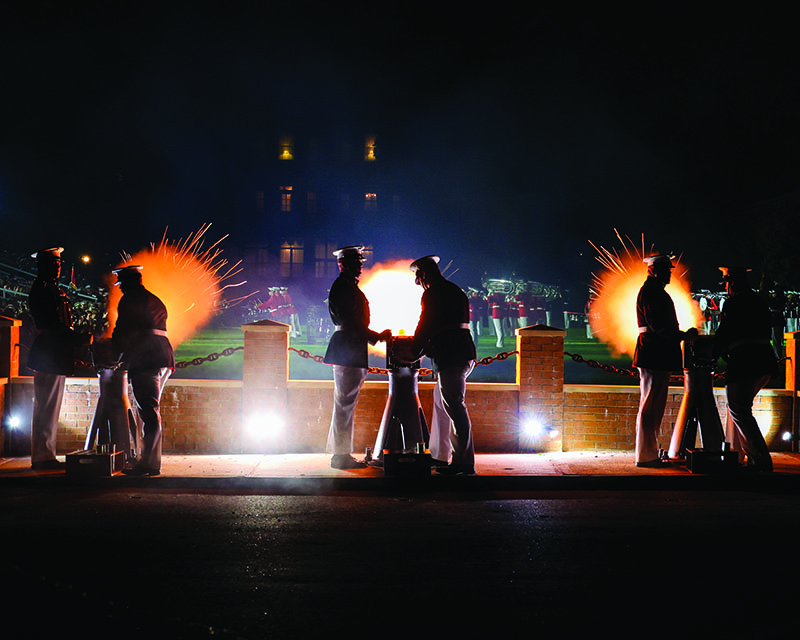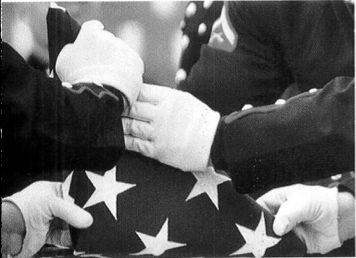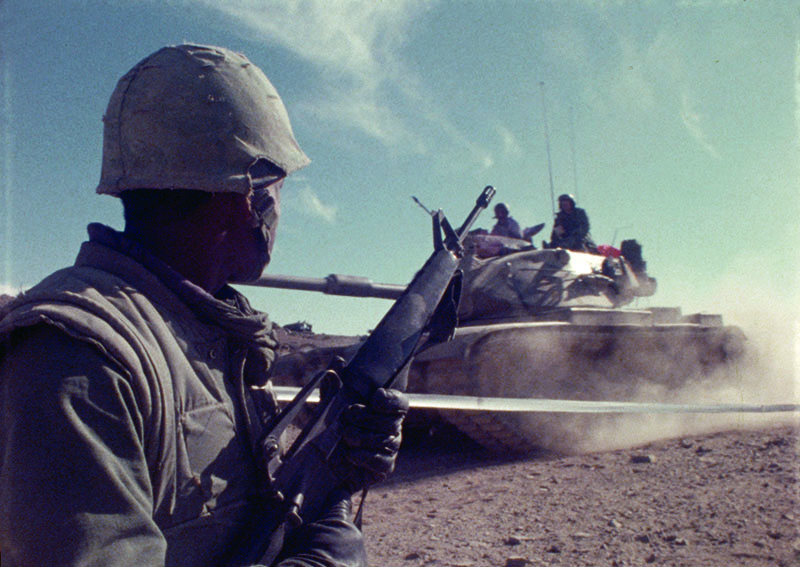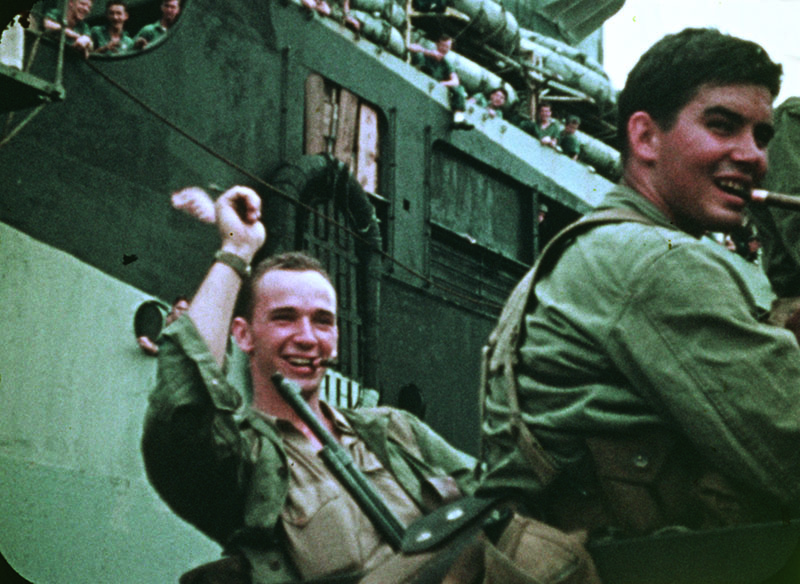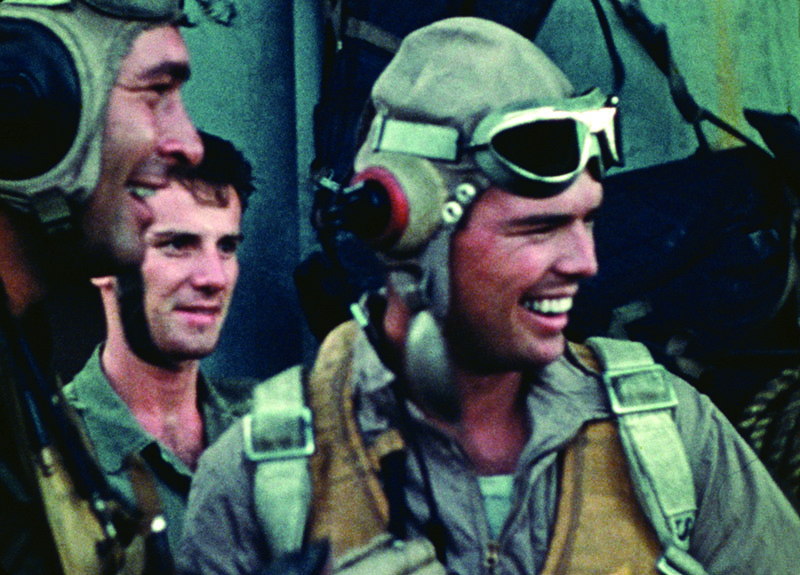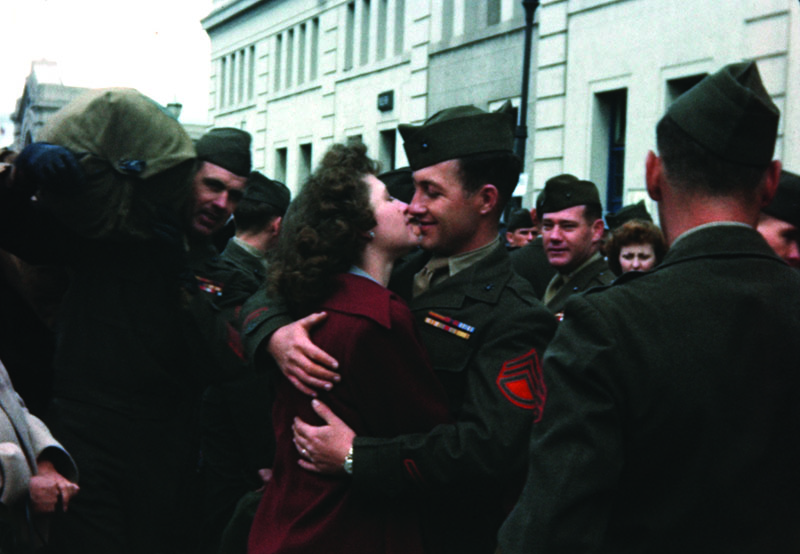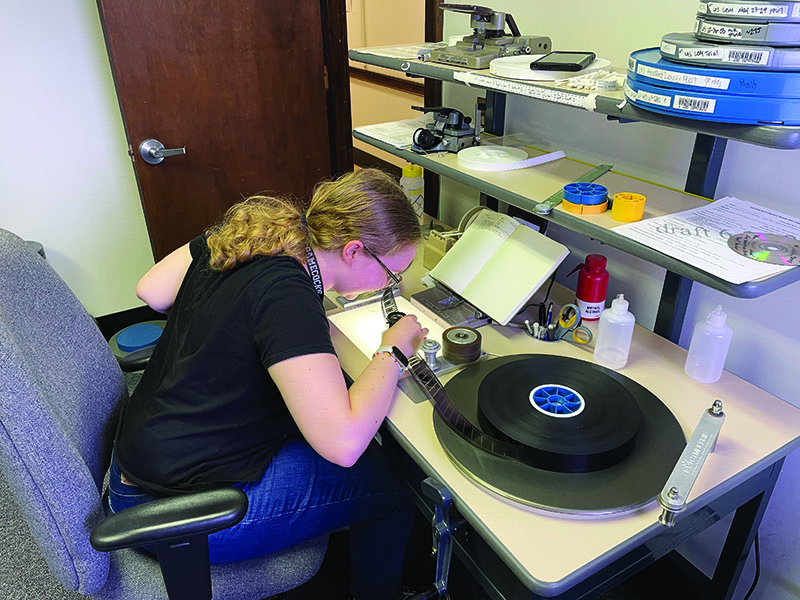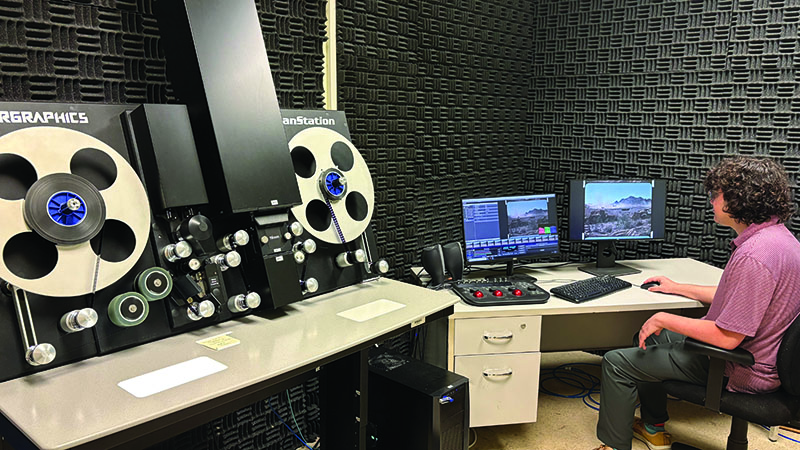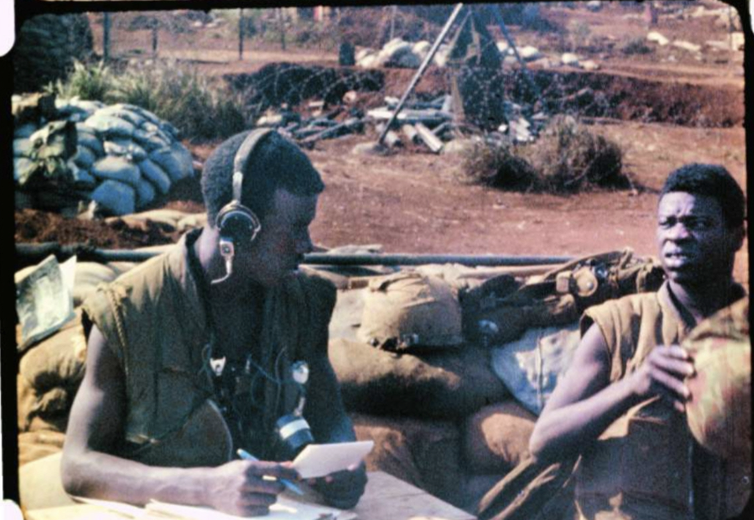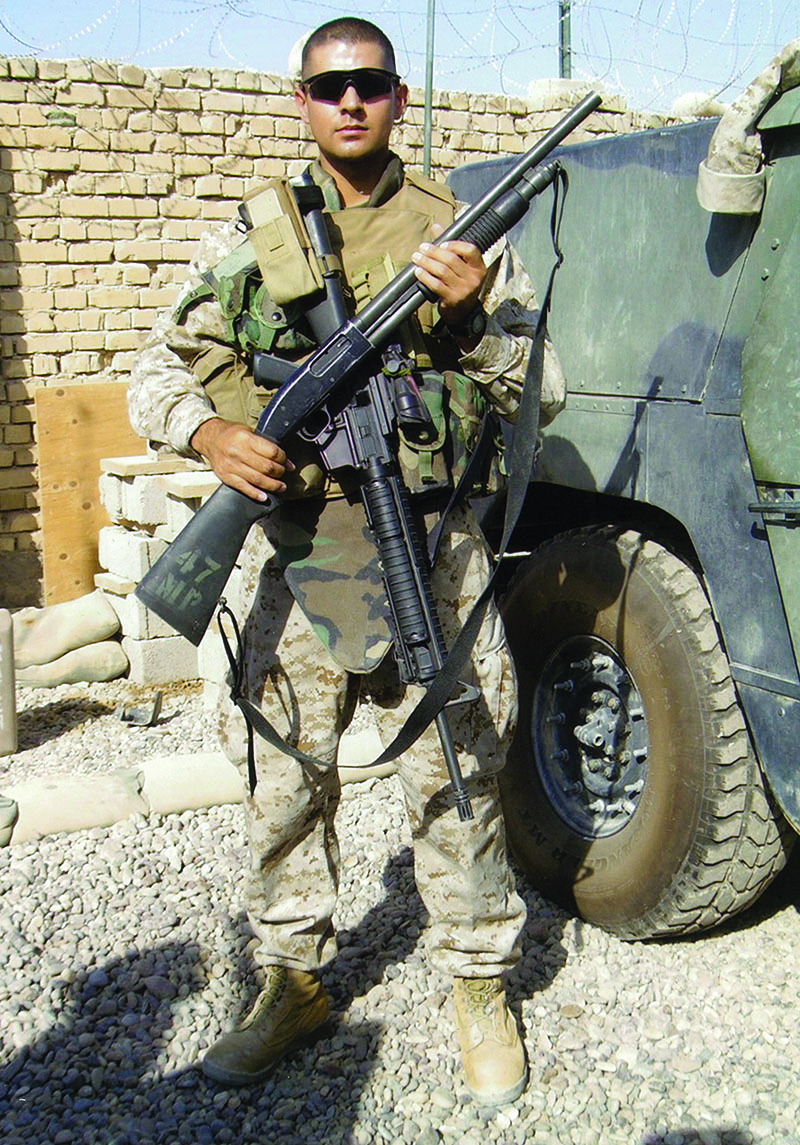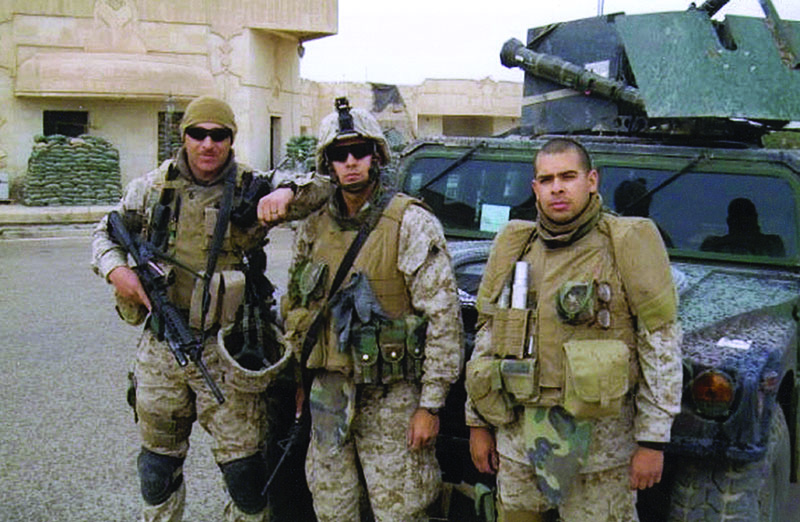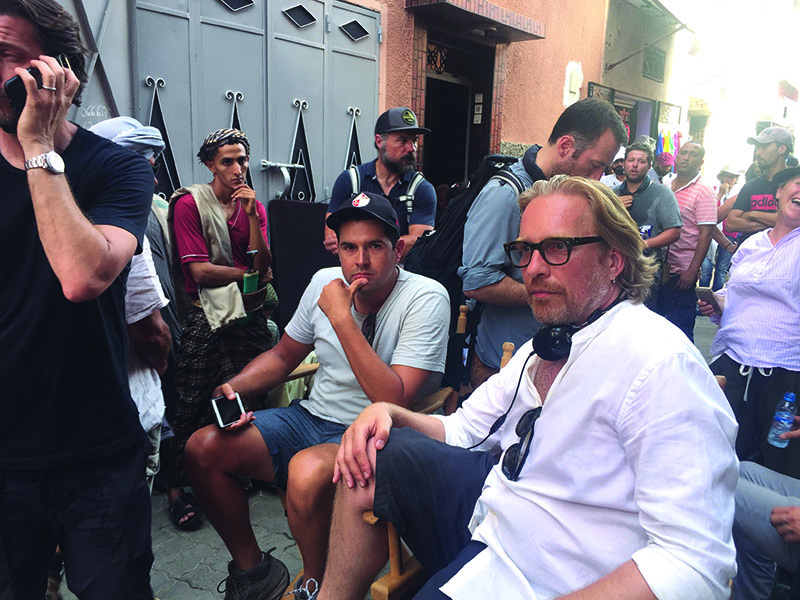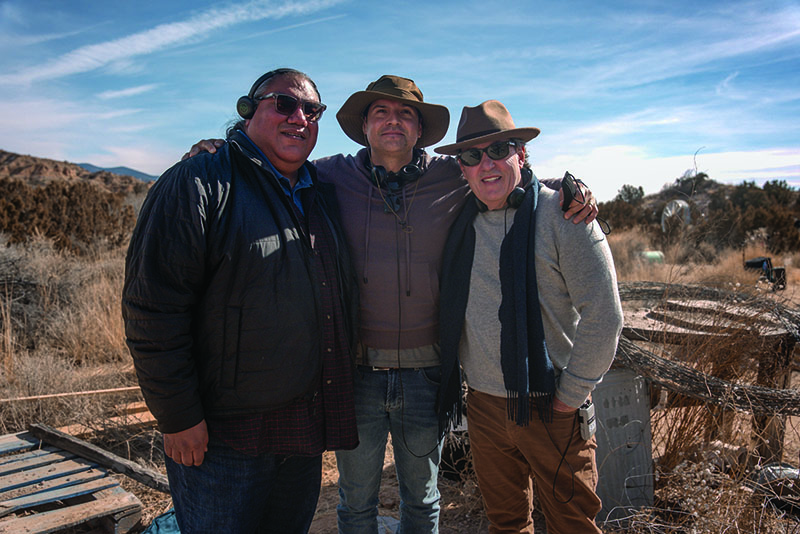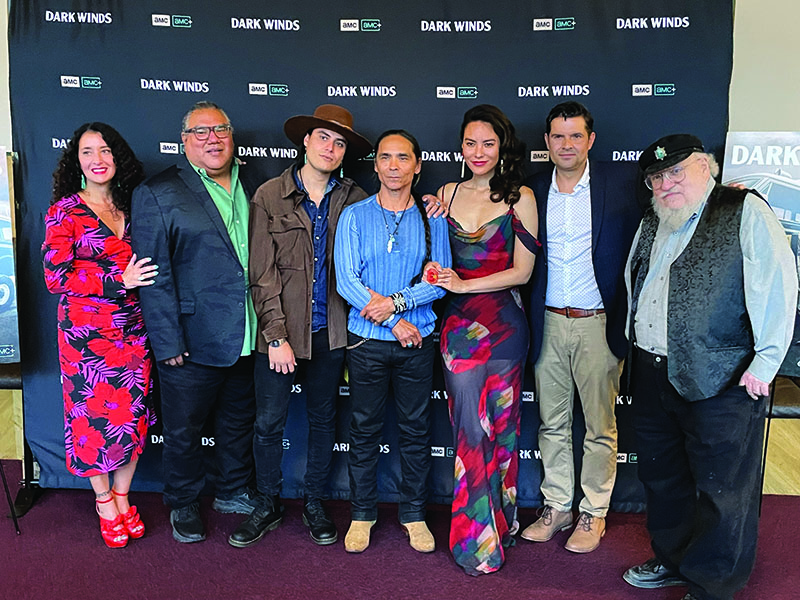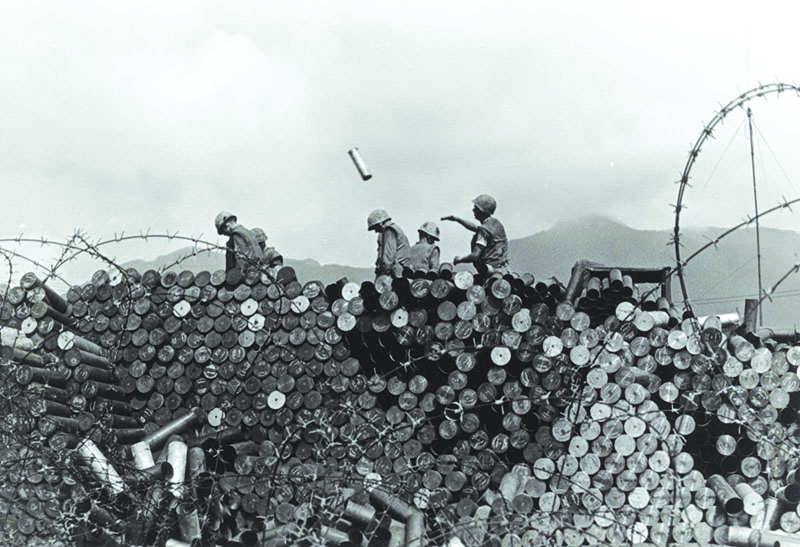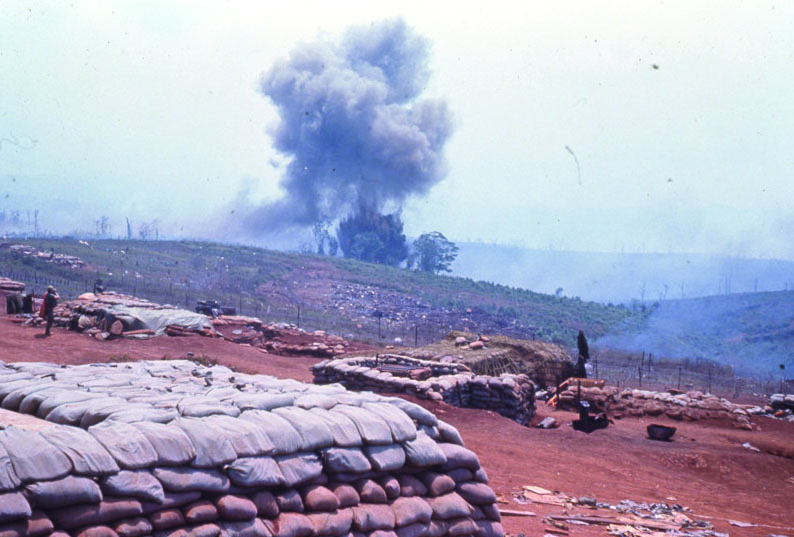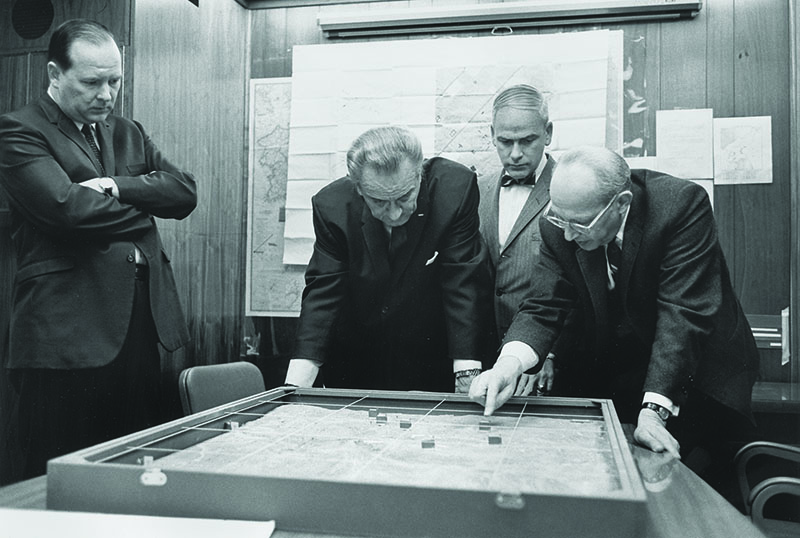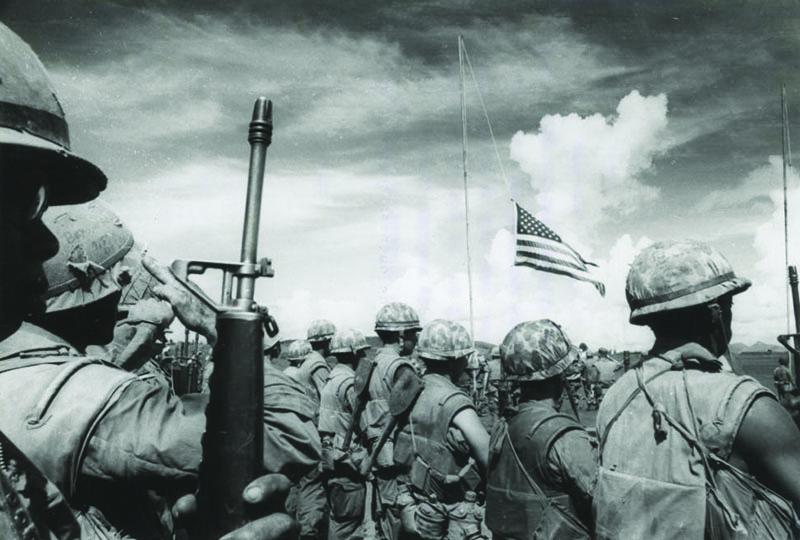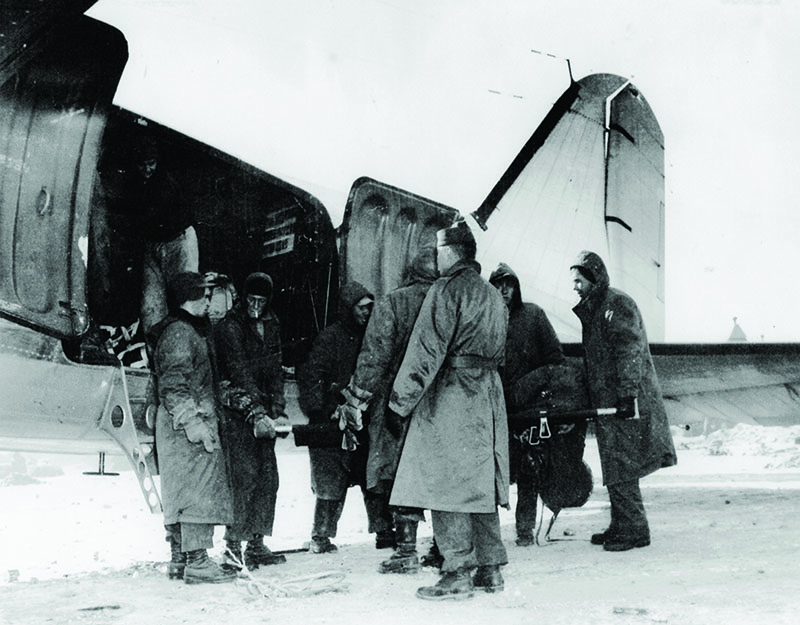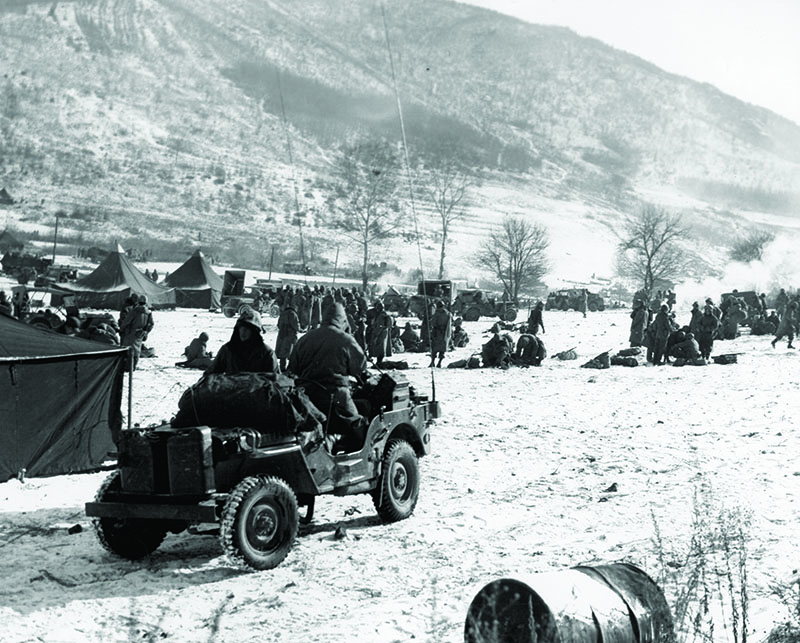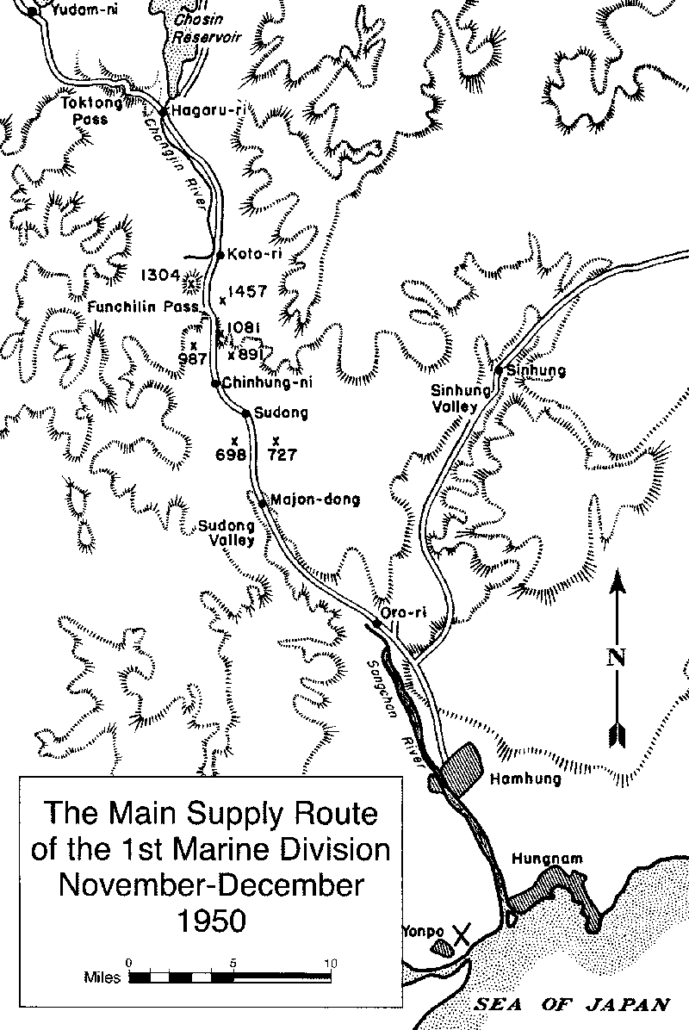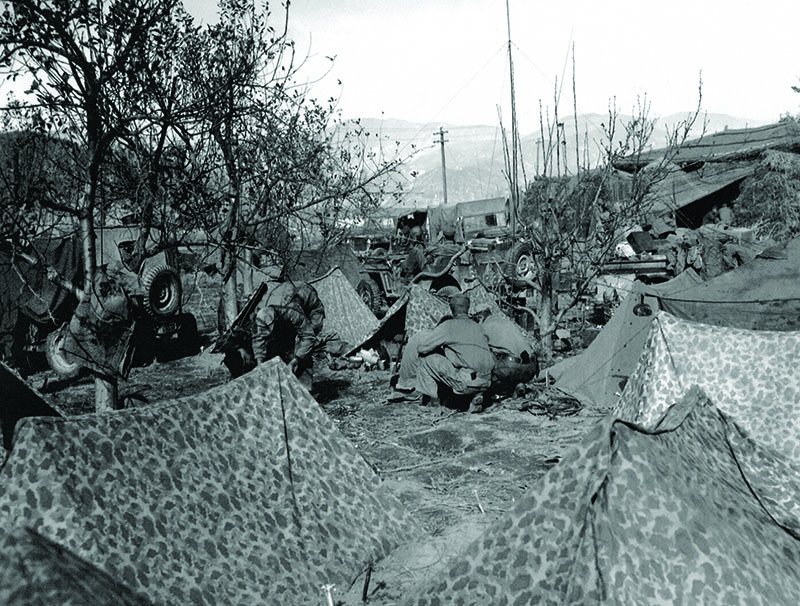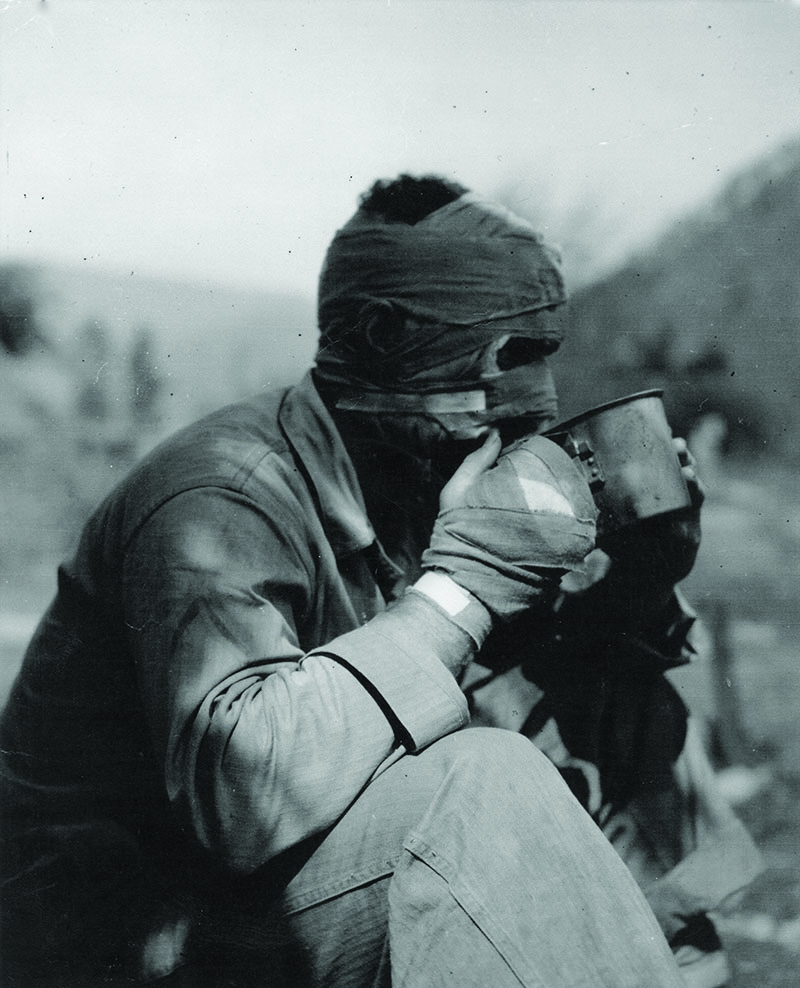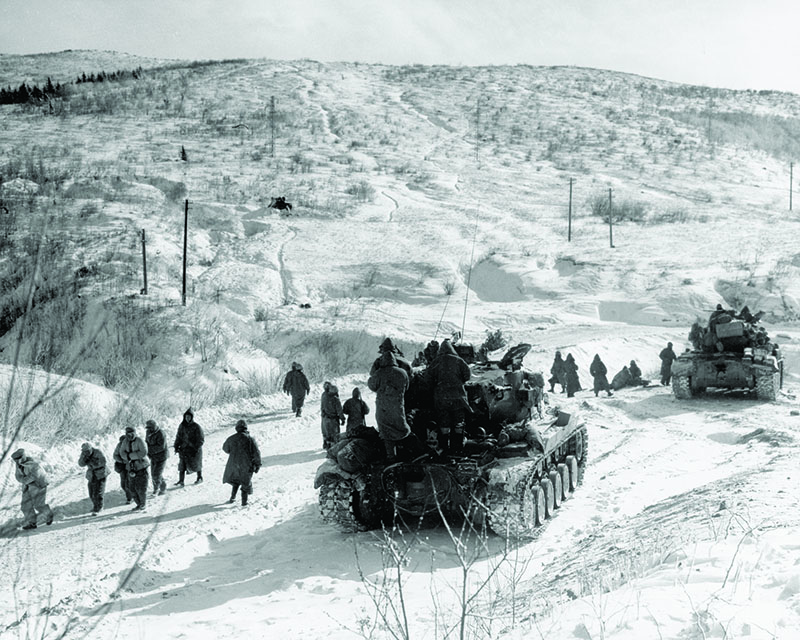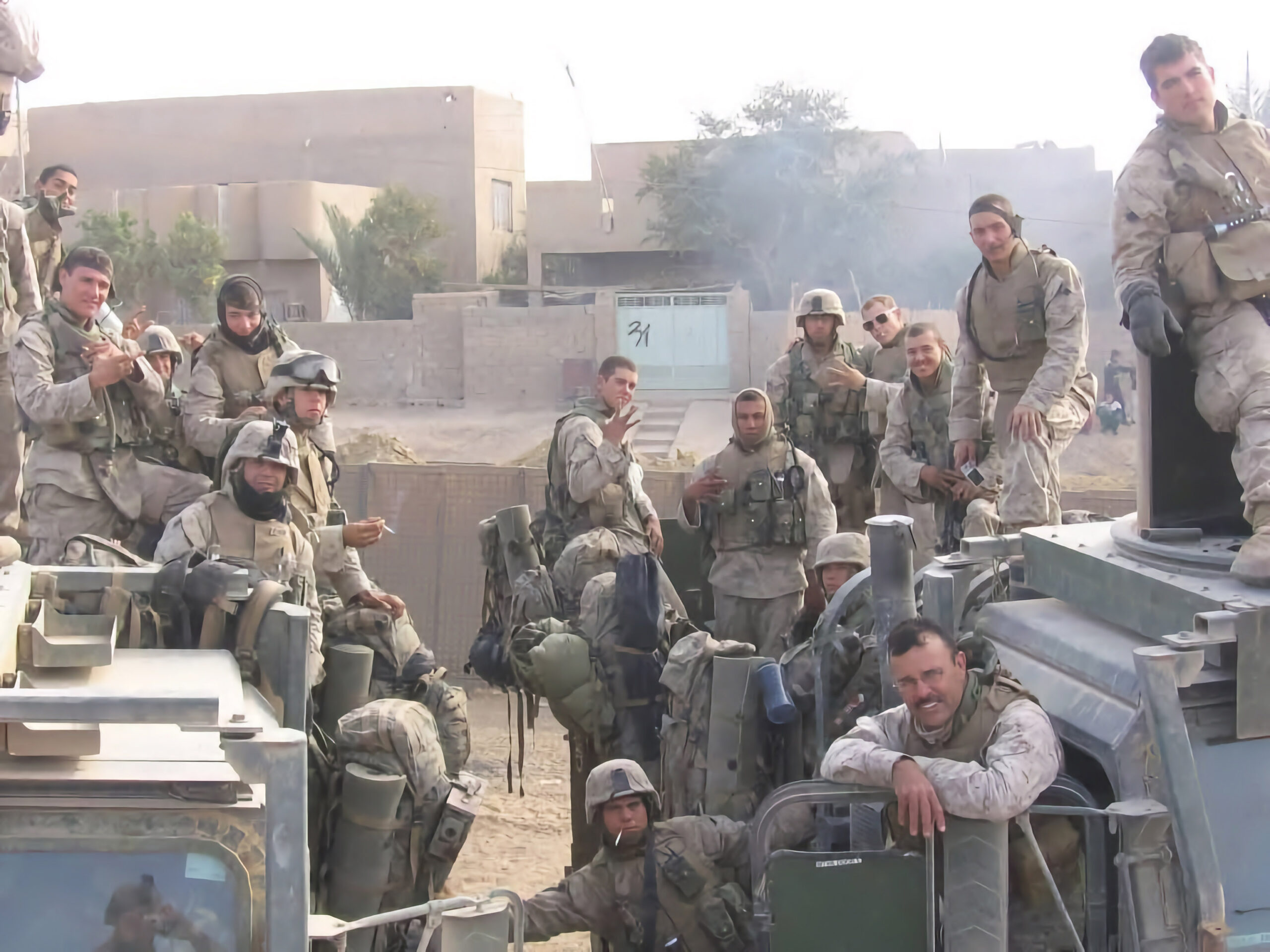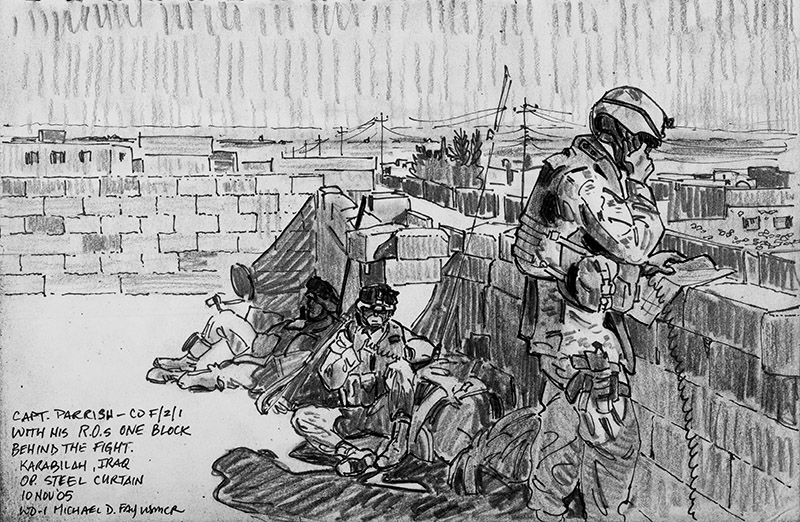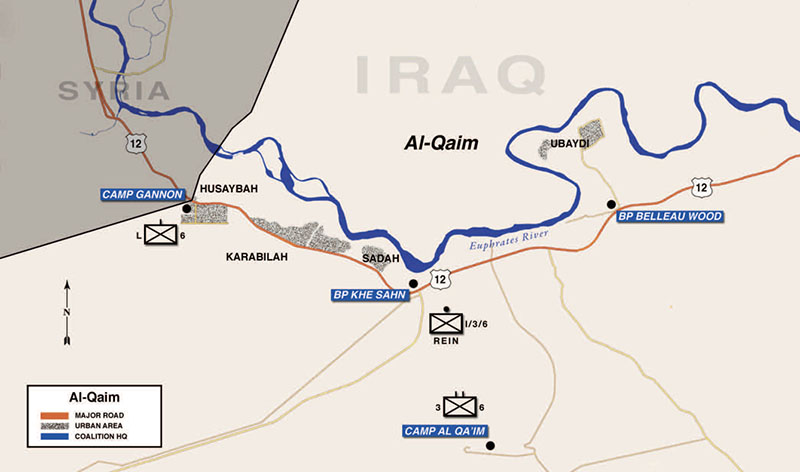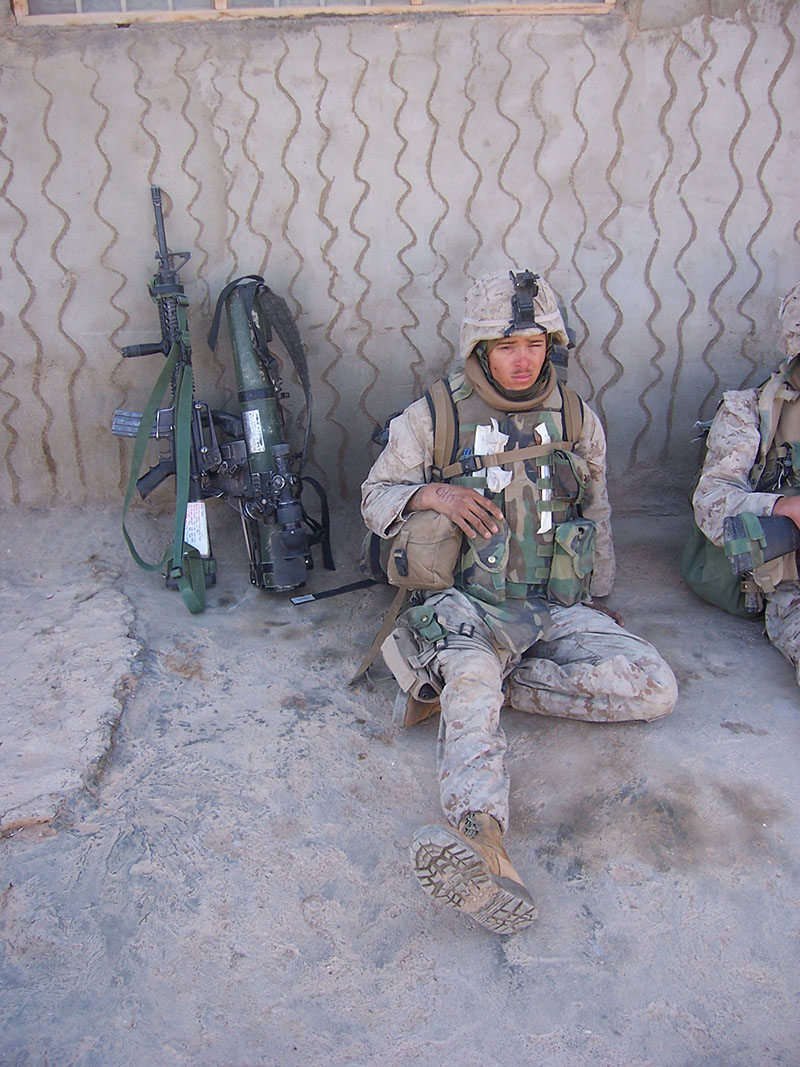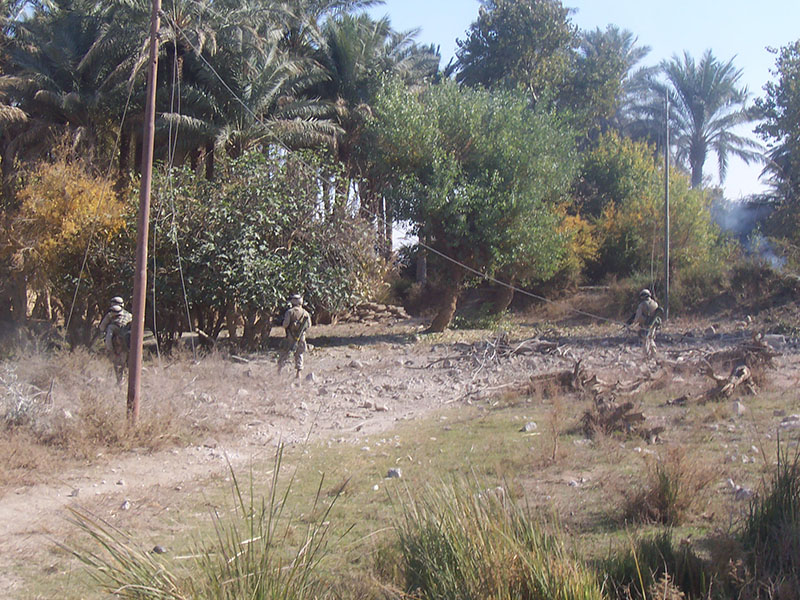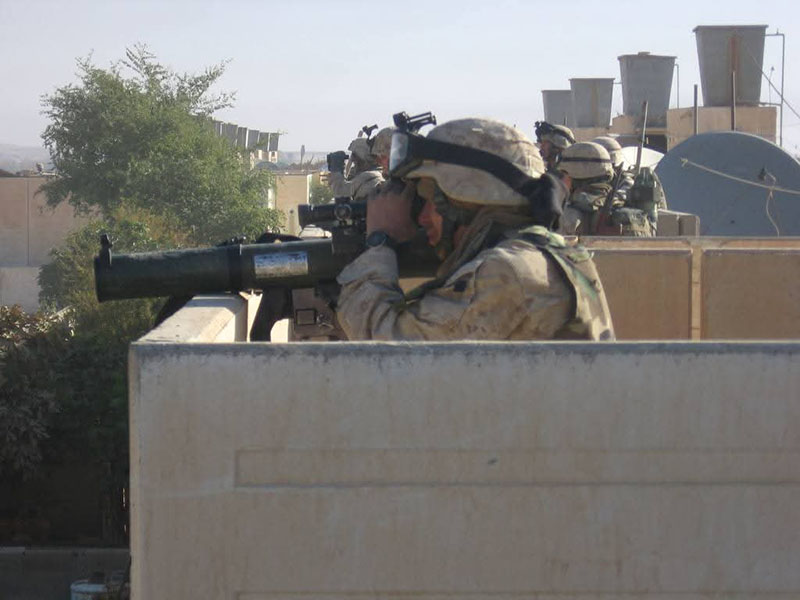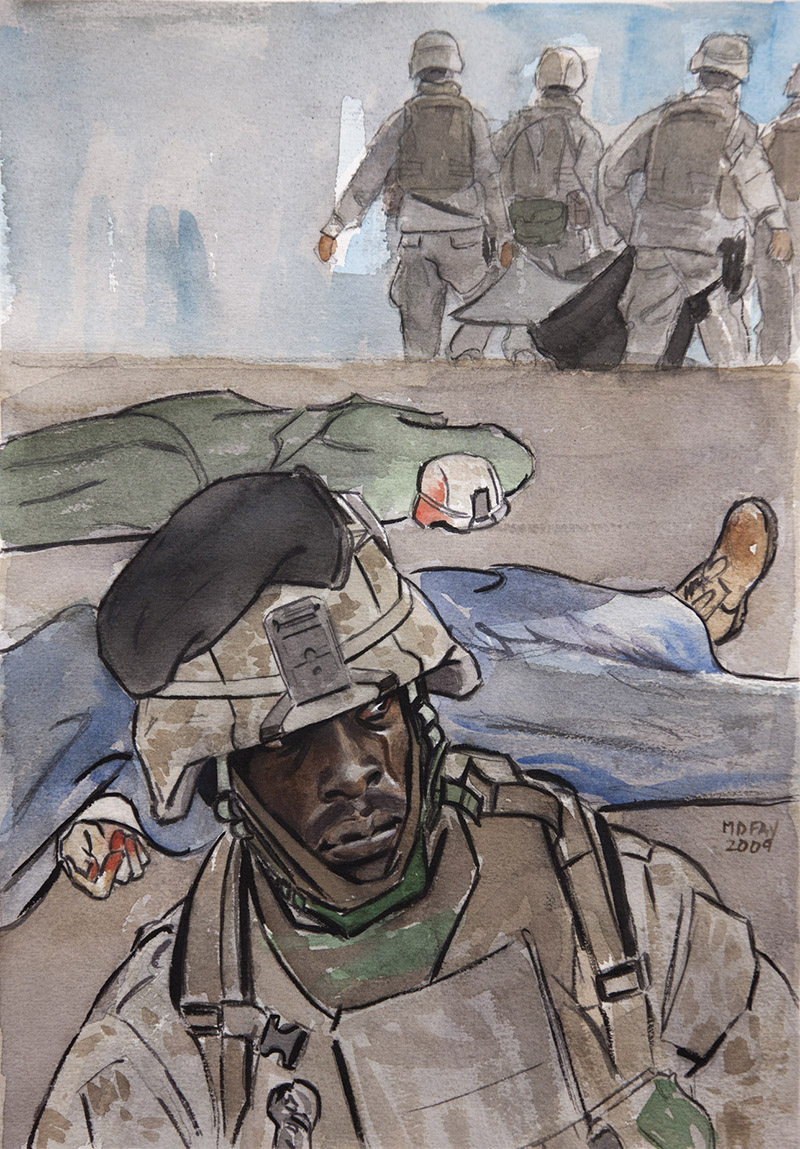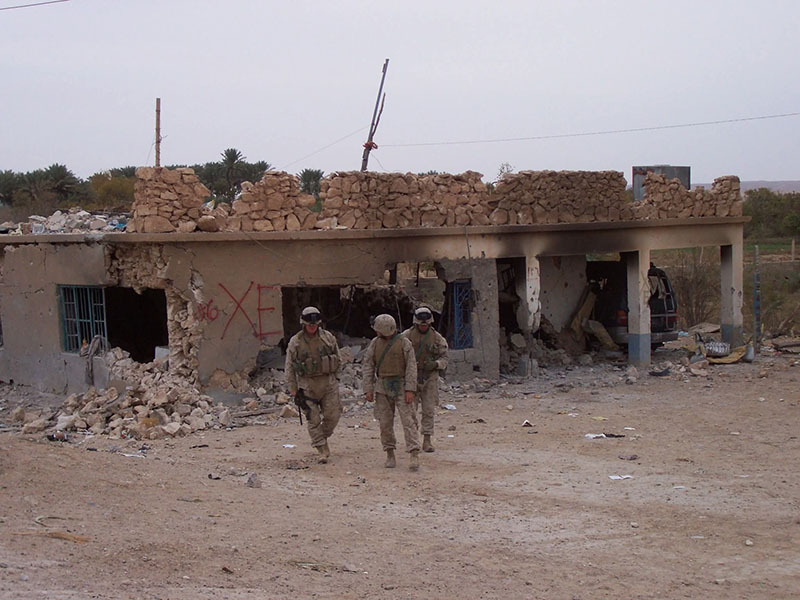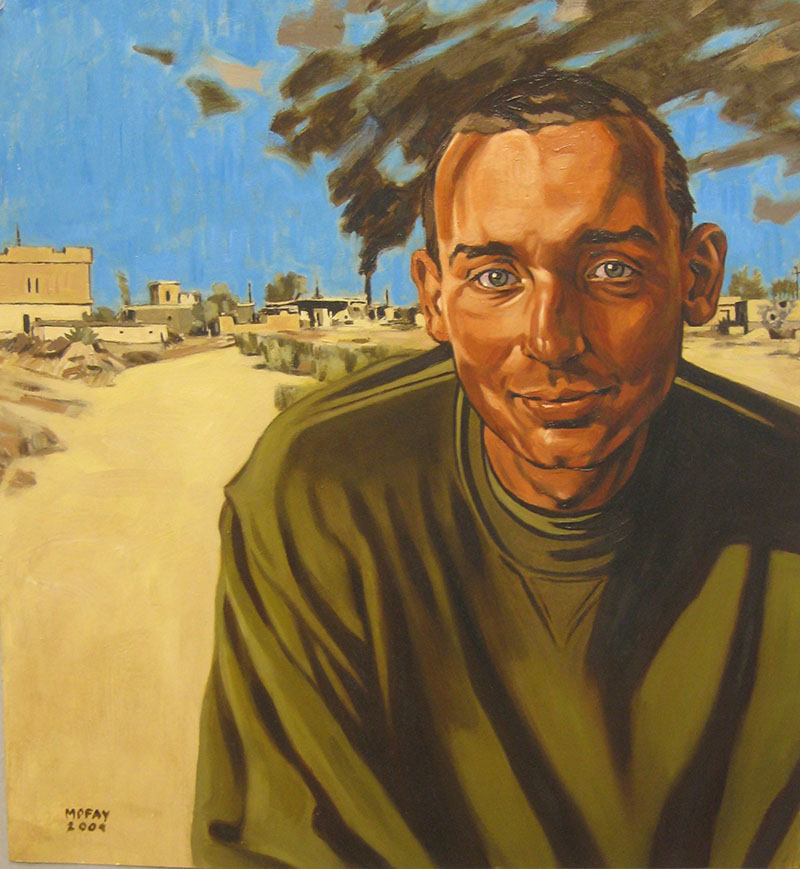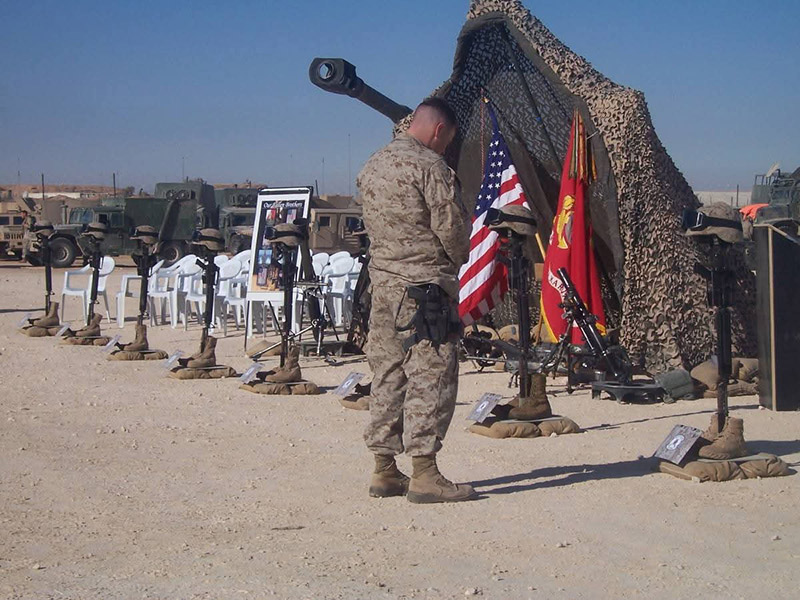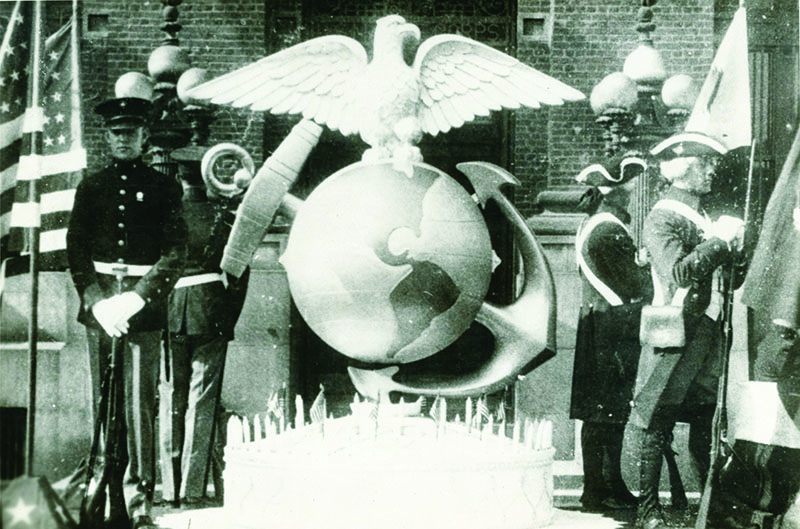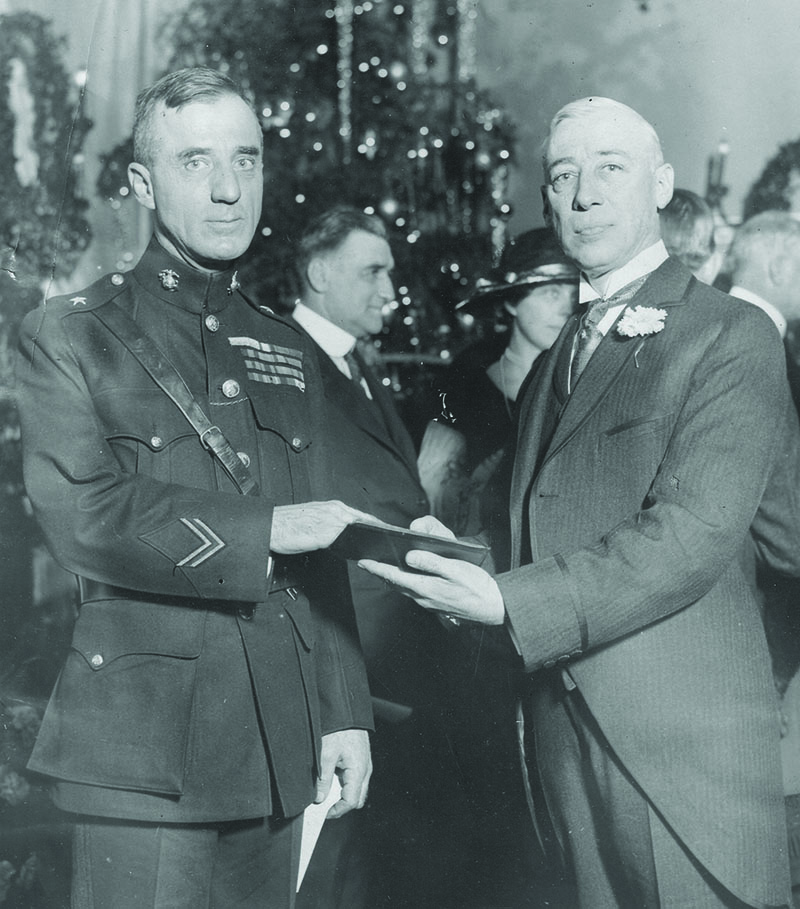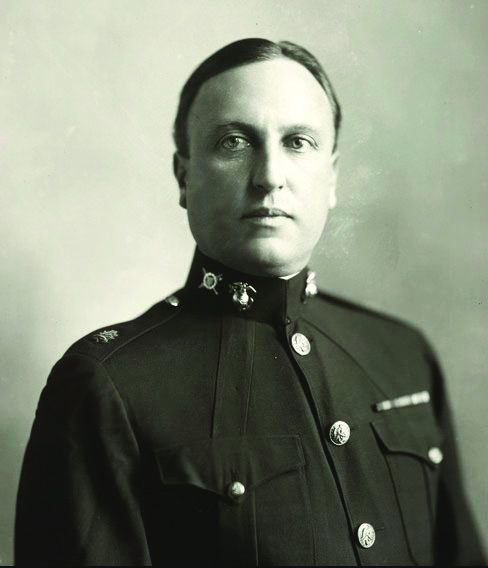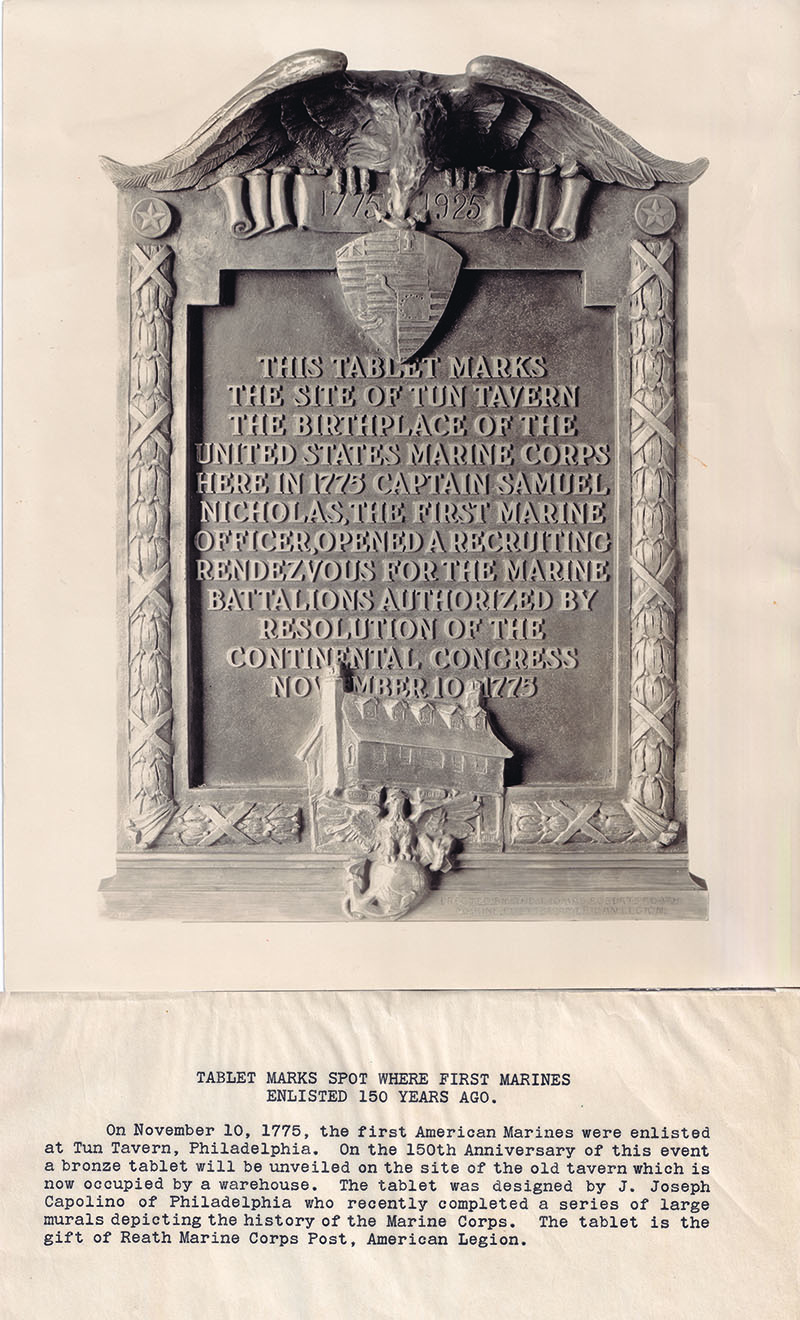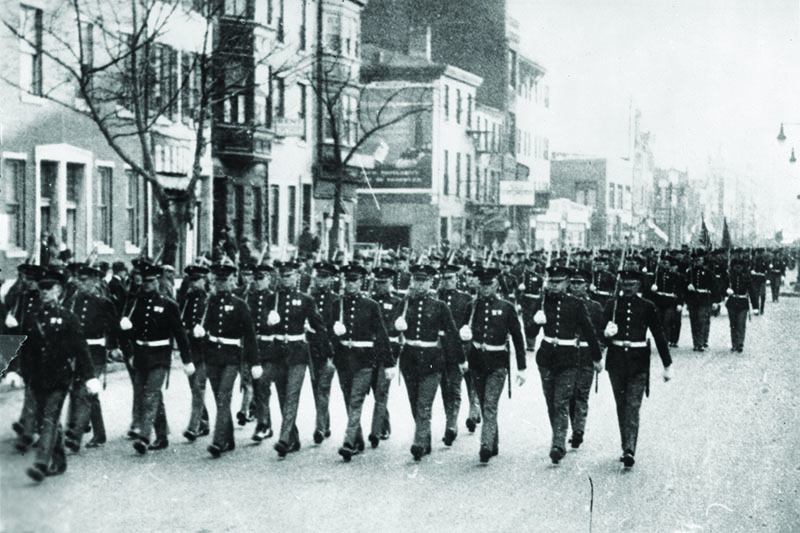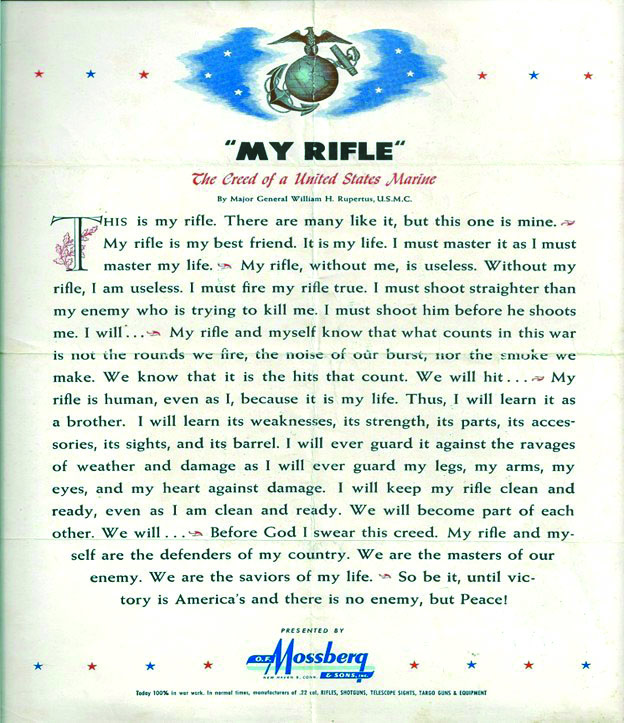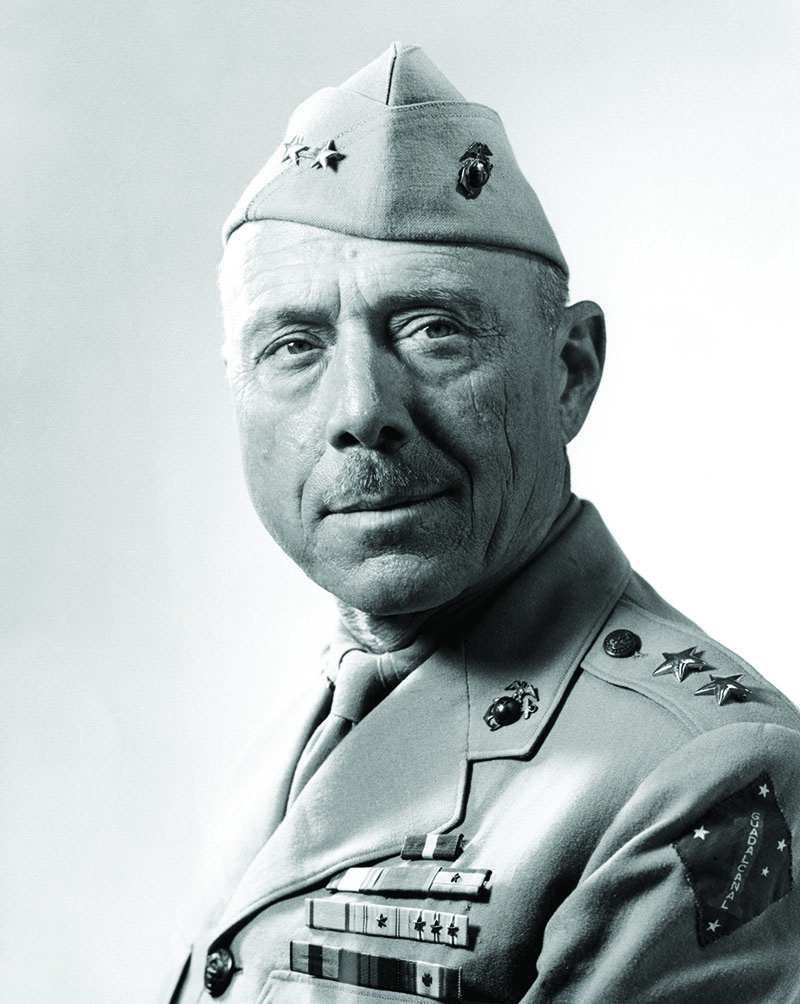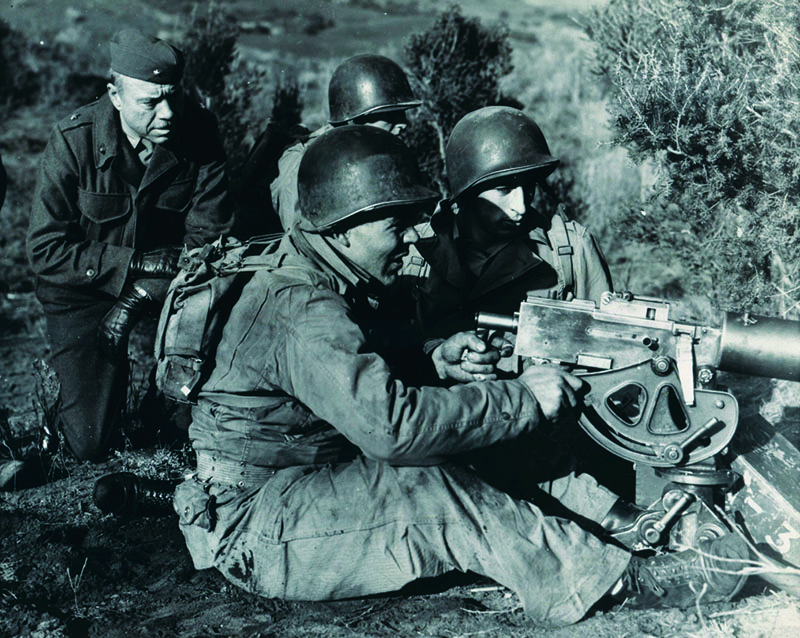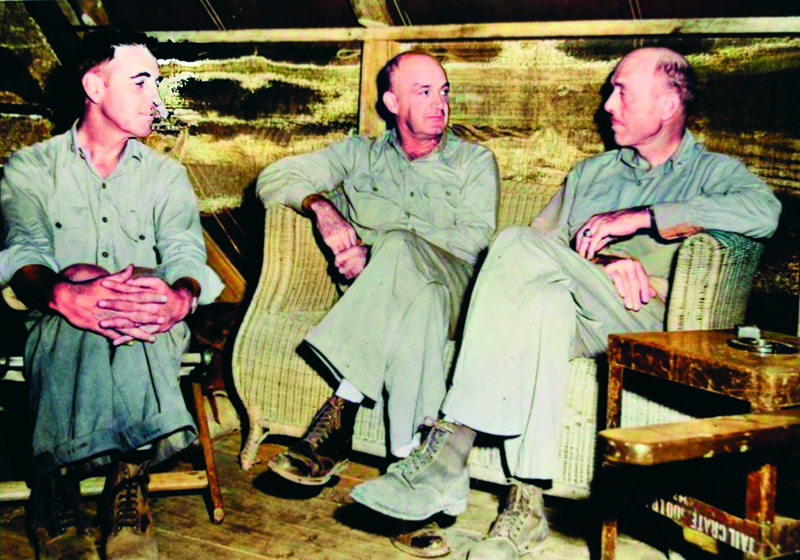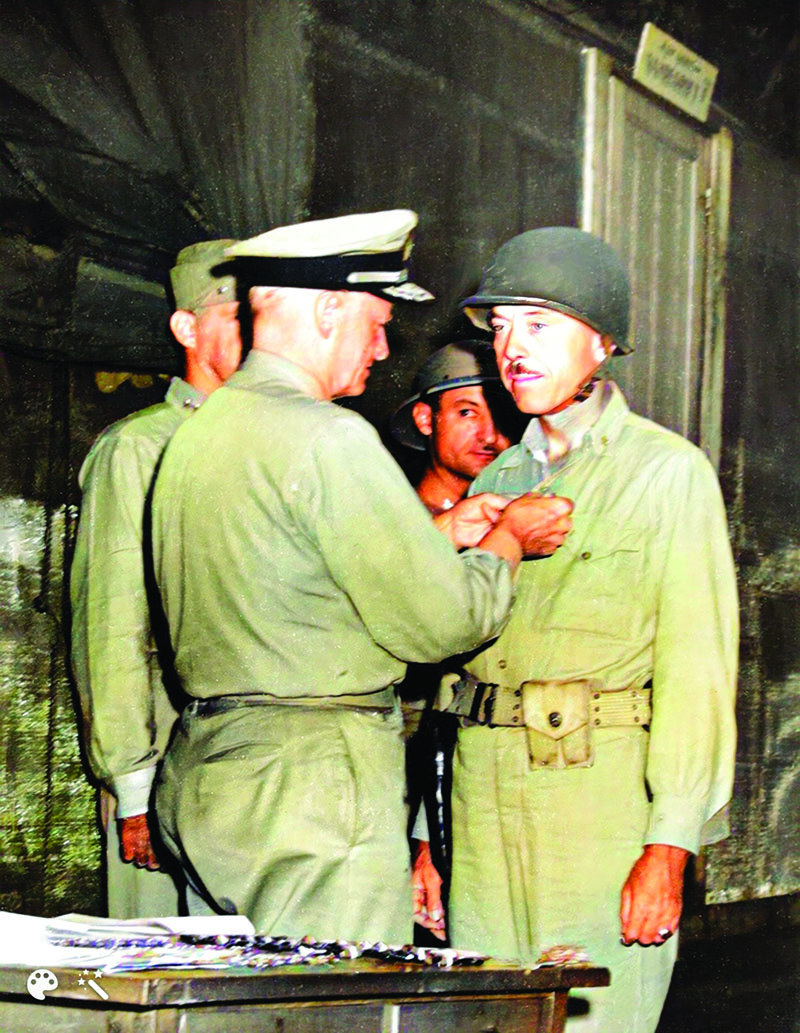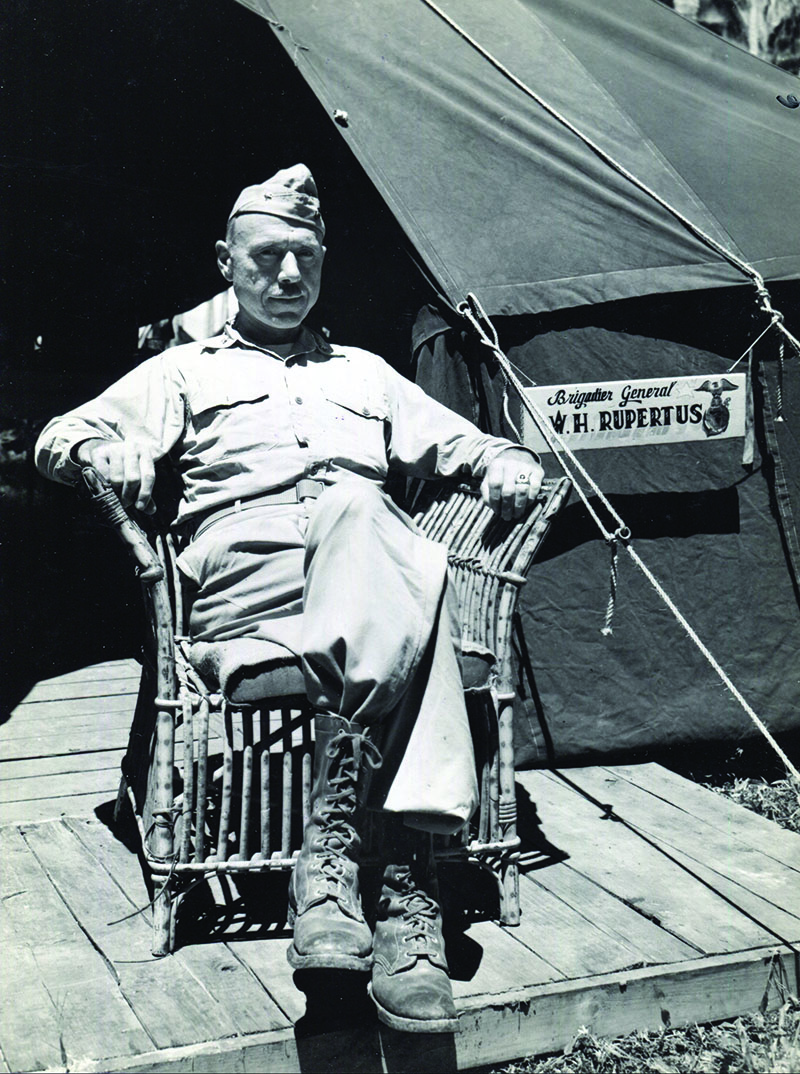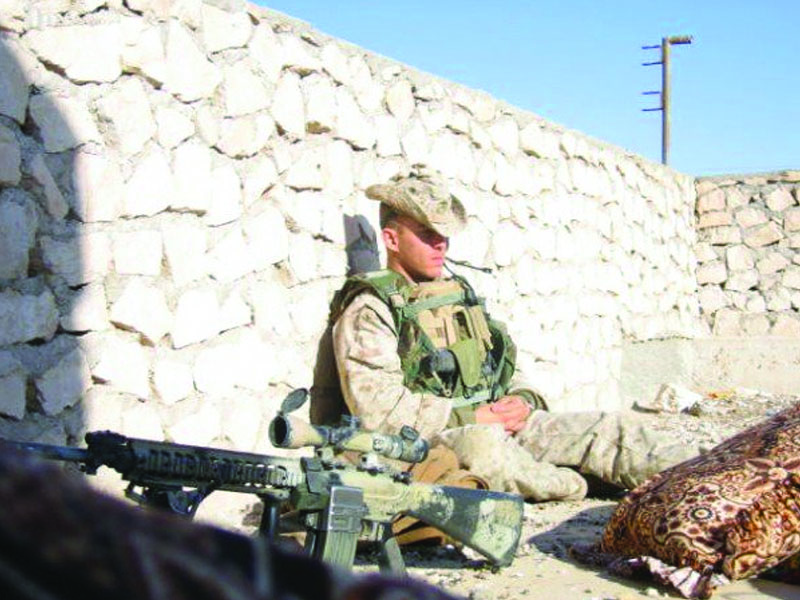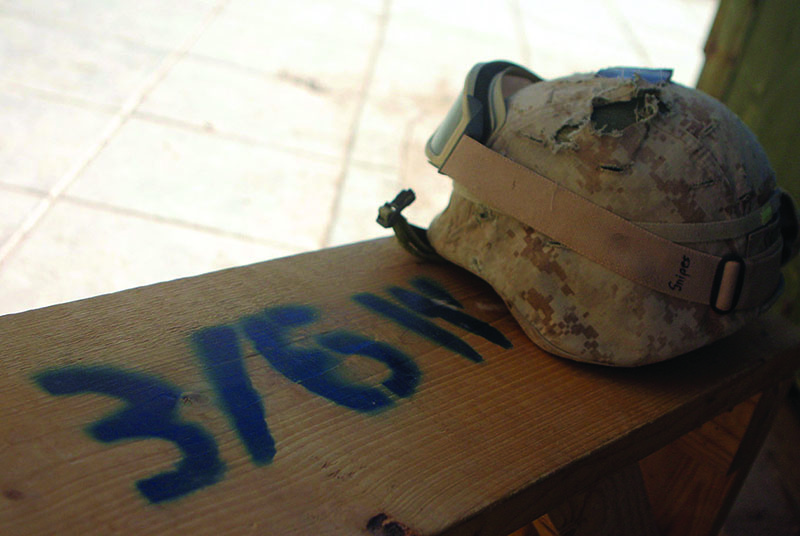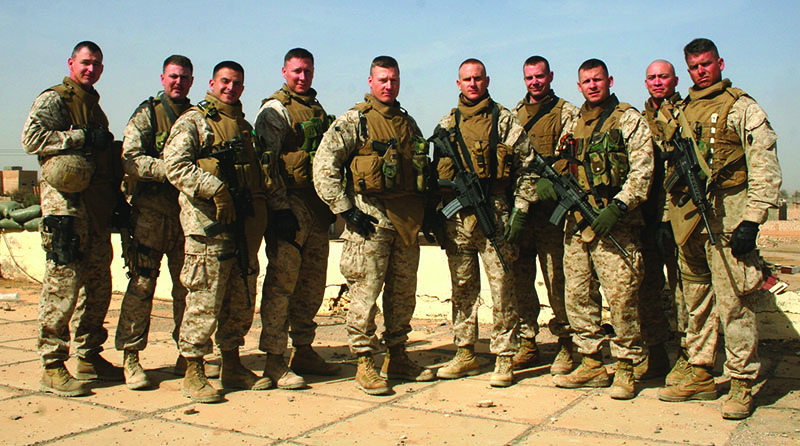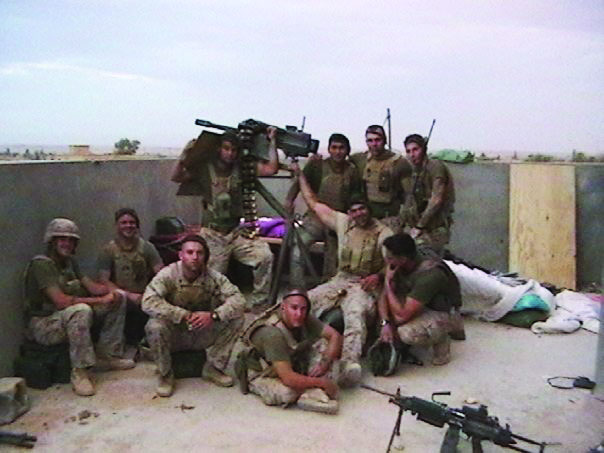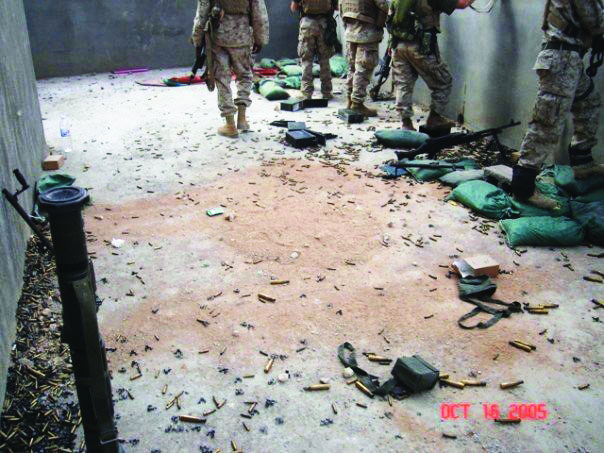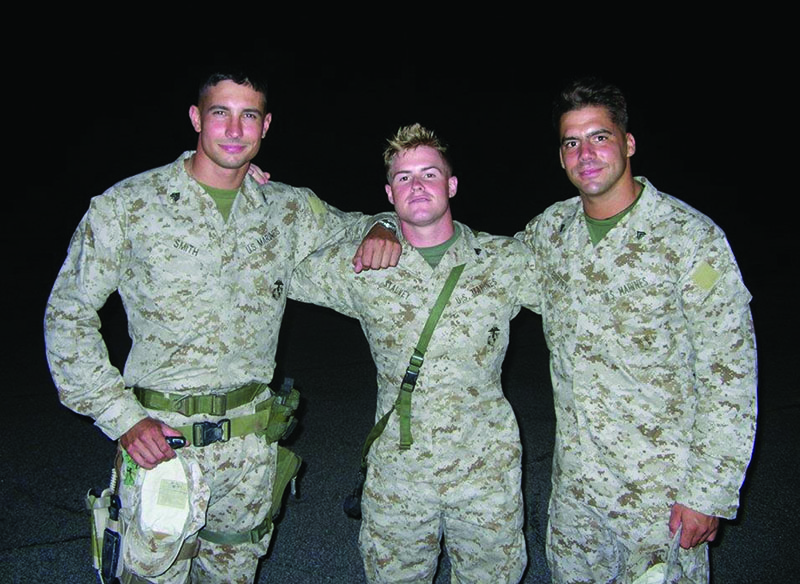Emergency Extractions and the Lifesaver from the Sky
Second Lieutenant John Slater froze in place and stopped breathing. More than 20 voices closed within 40 meters of his position. His force reconnaissance team had inserted 24 hours earlier into Base Area 112, west of An Hoa Com bat Base, Vietnam. North Vietnamese Army (NVA) soldiers combed the jungle, hunting the Marines from the moment they arrived. Now, with the enemy so close, the lieutenant’s request for air sup port was denied. The seven-man recon team would have to evade the NVA long enough to find an extraction site.
They escaped the enemy and survived another night. The next morning, Dec. 15, 1968, enemy soldiers again surrounded their position. Sporadic rifle fire came from multiple sides as the NVA attempted to locate and flush them out. Slater evaded the enemy once more and called for immediate emergency extraction.
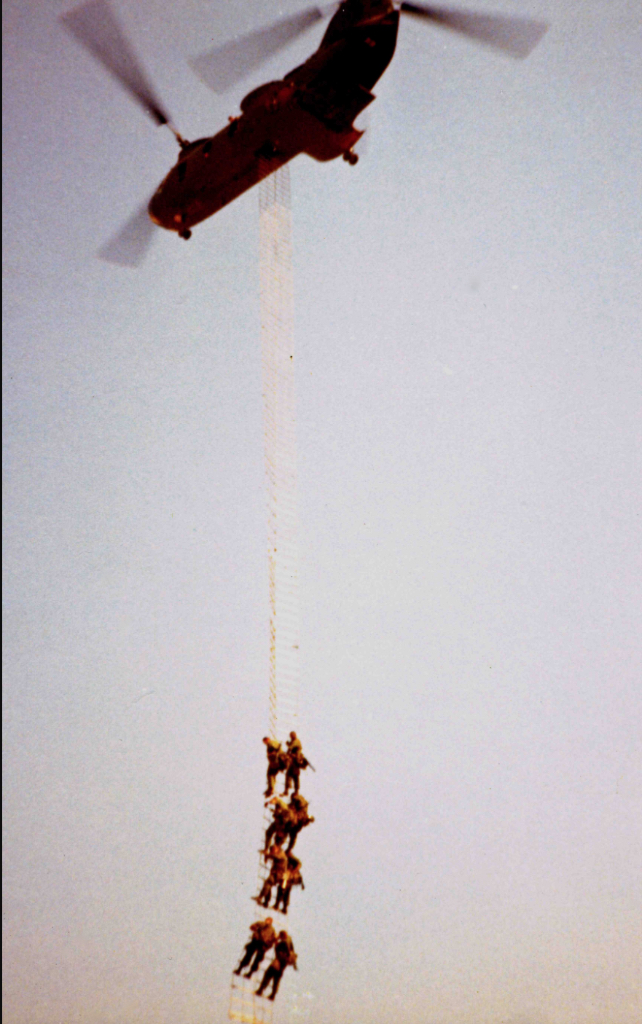
CH-46 pilot Captain Laurence “Larry” Adams landed his transport helicopter at An Hoa for refueling as 2ndLt Slater’s call came into the First Force Reconnaissance Combat Operation Center (COC). Adams diverted from his original mission to go get Slater and his men. The team’s escape had led them farther up the side of the mountain under 60-foot jungle canopy and landing a helicopter was out of the question. They would have to be hoisted up into the hovering chopper using a jungle penetrator. The device looked similar to a three-pronged fishhook with its seats folded down, and it was designed for one man. In perilous circumstances, however, two men wrapped themselves around the hoist and each other to reduce the number of trips required to rescue an entire team.
Capt Adams dropped his helicopter over the area where the Marines held their ground. As the jungle penetrator lowered through the trees, enemy rounds shot skyward toward the bird. Sixty seconds passed before the hoist finally hit the jungle floor. Two Marines hooked on with snap links and began the journey up. The weight of two gear-laden passengers severely slowed the hoist, more than doubling the time of the trip. The Marines clung tightly as they watched tracer rounds smack the belly and sides of the helicopter that was supposed to be their haven. As they reached the helicopter, the crew pulled them inside; more than five minutes had passed.
The hoist began a second trip. Adams struggled to keep the chopper steady under fire. Marine UH-1N Huey gunships let loose at the enemy below. One friendly rocket exploded so close to Adams’ helicopter that shrapnel cut holes through the side along with the enemy fire. He could hear voices over the radio. “Two more on, but there’s still three on the ground!”
“Don’t worry,” he shouted into his microphone, “We’re not going anywhere; we’ll get you out!”
Nearly 15 minutes passed before the second group of Marines safely boarded the chopper and the jungle penetrator returned to the ground for a third trip. The CH-46 continued taking hits but miraculously stayed aloft. Two more Marines crowded onto the hoist. Lt Slater remained on the ground with the enemy closing in and the helicopter under continuous fire. Believing another five minutes alone on the ground meant certain death for his entire team if the aircraft went down, Slater grabbed the jungle penetrator as it lifted. He slid both arms under the legs of one of his Marines and held firm to the folded down seat. The Marine reached down and grabbed Slater’s belt. From his position under the hoist, it was impossible for Slater to hook up.
Adams lifted off as soon as the last of the team was on the hoist. Slater and the others scraped through the trees as they rose above the canopy. The crew chief tried to reel in the hoist, but discovered the weight of three Marines plus their gear was too much. He could not pull them up. Adams decided to land the helicopter to bring in the remaining Marines. He found a large sandbar 6 miles north and headed straight for it. The flight lasted only a few minutes, but tragically, that was longer than Slater’s strength could hold. As the helicopter approached the sandbar, Slater lost his grip on the jungle penetrator and plummeted 100 feet to his death. They landed, recovered his body and returned to An Hoa.
Back at the COC, First Lieutenant Andrew Finlayson reflected on the disaster. As the operations officer, he manned the other end of the radio with Slater the whole time. Almost two years earlier on his first Vietnam tour, Finlayson patrolled the same area his Marines now covered. He knew if they remained here for much longer, they needed a better way to get teams out.
Less than one week earlier, 1st Force Recon had moved to An Hoa. Slater’s team was one of the unit’s first patrols sent into the surrounding jungle, known as Base Area 112. The Marines faced innumerable difficulties here, gathering intelligence in support of Operation Taylor Common. Jungle-covered mountains dominated the area and few viable landing zones (LZ) existed. This was NVA country, flush with supply routes, fighting positions and professionally trained soldiers to man them. The NVA developed tactics specifically targeting recon patrols. They manned every feasible LZ to prevent inserts and extracts and patrolled on line to push teams out of hiding. Every aspect of the Marines’ new area was stacked against them.
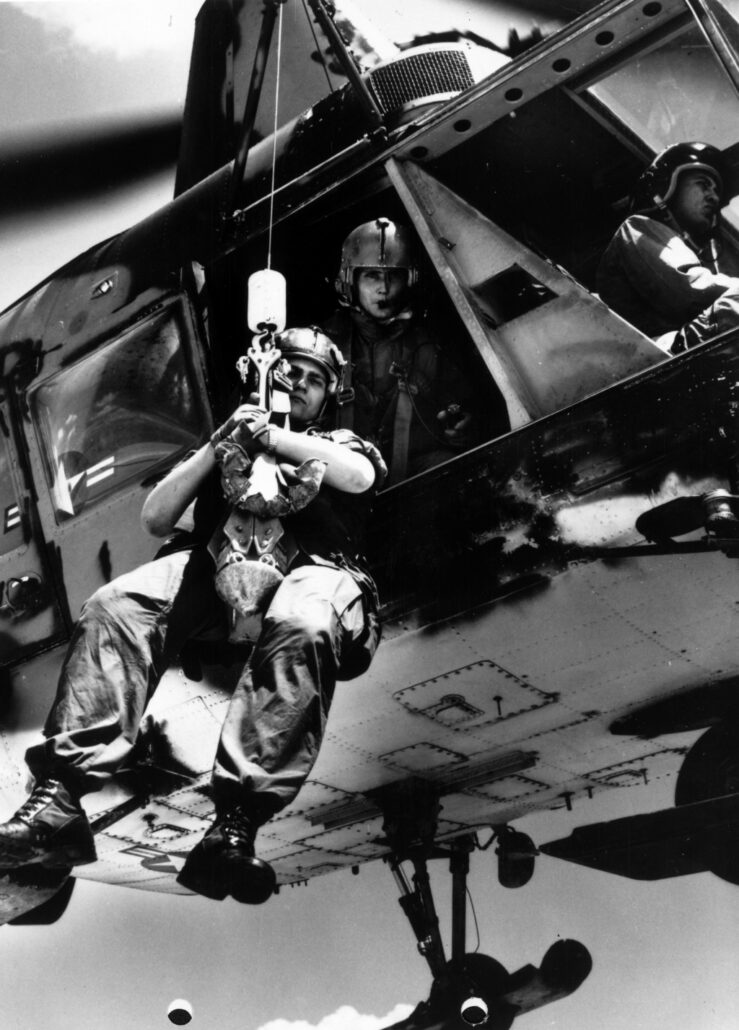

A recon team’s intelligence value remained highest as long as they were undetected. “Once a team made contact with the enemy, they really couldn’t carry out their mission,” said Finlayson, now a retired colonel and author of two books on his tours in Vietnam. “Then it became a case of simple survival. They’re either running to avoid the enemy or fighting for their lives.” In these circumstances, a team’s best course of action was to break contact, evade the enemy, and call for extraction. Until Operation Taylor Common, jungle penetrators were used to great success despite their weaknesses. Many recon Marines rode the hoist and owed their lives to it. Base Area 112 and the enemy who inhabited it, however, were not as forgiving. The amount of time it took to extract a full team was too long.
Major Roger Simmons, commanding officer (CO) of 1st Force Recon, tasked Lt Finlayson with finding an alternative. To help, he sent Finlayson to the Army’s elite Studies and Observations Group (SOG). Their experience inserting and extracting teams deep behind enemy lines inspired numerous devices for the task. Finlayson borrowed two concepts: the Stabilized Body (STABO) harness which seemed simple enough to adapt and produce and a giant swinging ladder.
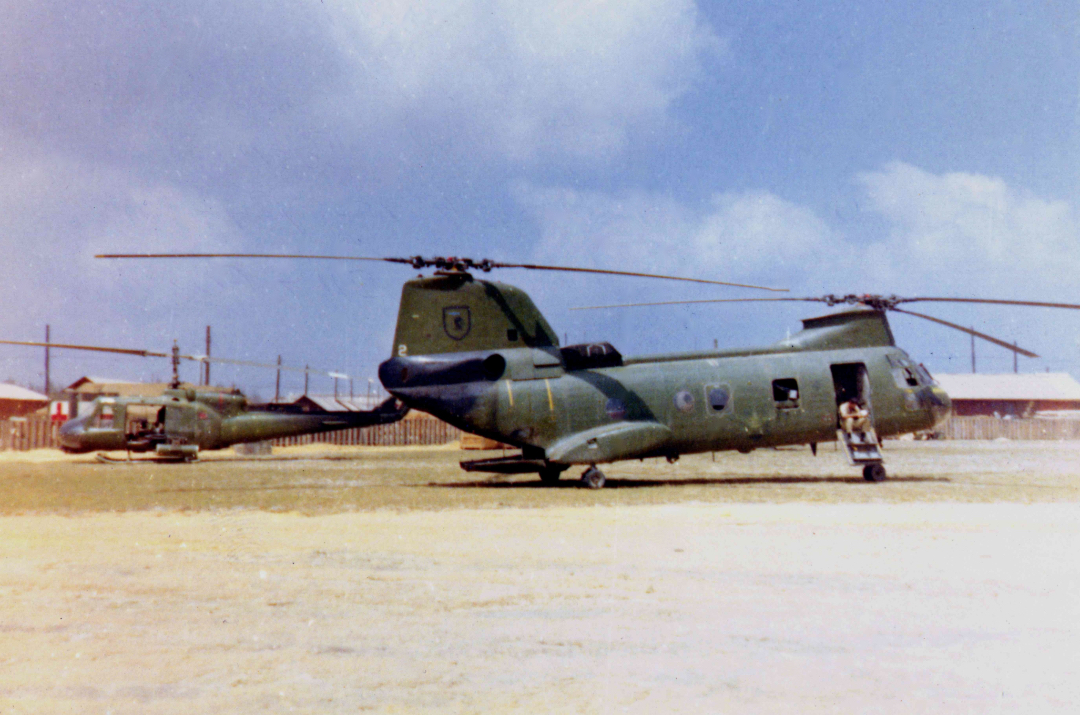
The ladder, made of aluminum rungs and wire, was designed to roll up on the floor of a helicopter and kick off the tail when needed, unraveling to the ground. The Marines combined multiple sections of the original device, making it 8 feet wide and 80 feet long. An entire team could snap onto the ladder at once, and with no way to reel it in, no additional time was spent hovering. Marines extracted with this ladder knew they were in for a wild ride.
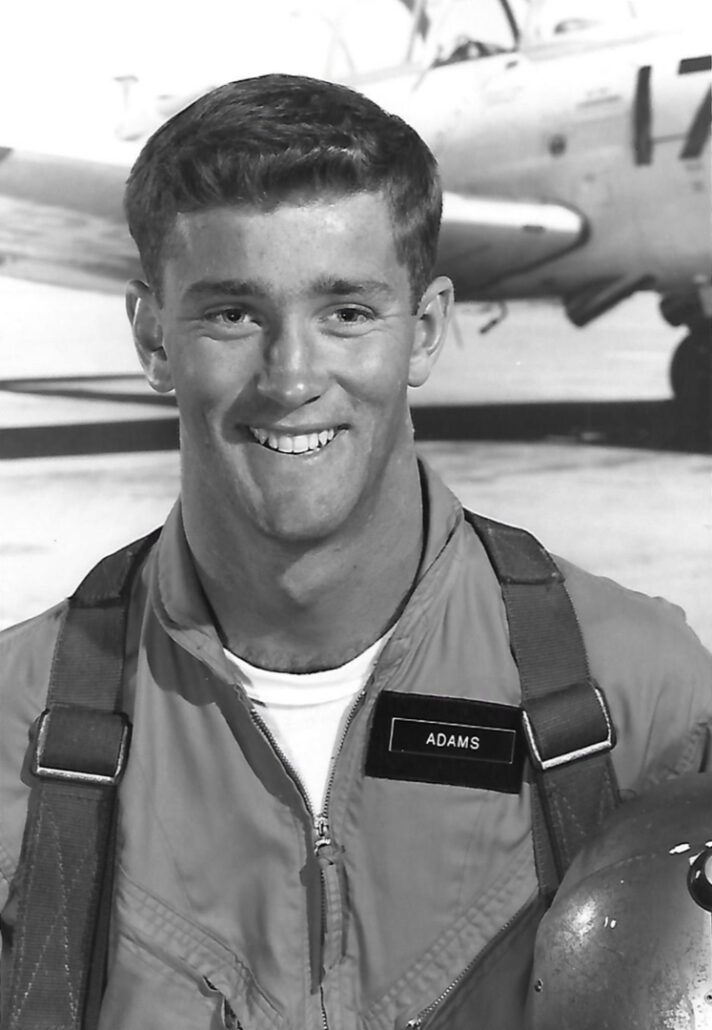
The device did not come without problems. The most serious risk came from the Marine CH-46 helicopters using the ladder. When pilots tested the device, they found it extremely difficult to lift off with a full recon team hanging below. The monumental task of steadying the chopper required perfect coordination between the pilot and crew. Air wing commanders did not approve the ladder for use in combat. Despite the risks, 1st Force Recon unanimously accepted the ladder as a great improvement over the jungle penetrator and began training with the device right away. In honor of their CO, the Marines rebranded the ladder as the Simmons Rig.
1st Force Recon patrolled through the New Year into January 1969. With hovering inserts and extracts on the rise, Maj Simmons decided more training was necessary to keep his Marines’ skills fresh. He gave the job of Insert/Extract Noncommissioned Officer (NCO) to one of his most experienced patrol leaders, Sergeant Robert “Bob” Buda. In his new role, Buda mastered the rigging and utilization of all insert/extract methods and provided the company with training. Few in the country were better suited for the role.
Buda arrived in Vietnam in November 1967. After 13 months, 45 patrols, six combat dives and two Purple Hearts, the 20-year-old platoon sergeant was an invaluable resource. It seemed like anything you could imagine behind enemy lines was something he had already experienced and survived, earning two Bronze Stars with combat “V” in the process. Buda extended to remain in country as the end of his tour approached. “My mindset was such that the only family I had was the guys at 1st Force Recon,” remembered Buda. “My family just became the guys at the unit and I had no intention of going home. I was going to stay there forever, I thought.”
His new position seemed perfect. It allowed him to remain with 1st Force Recon while minimizing the risk of a third Purple Heart—an automatic ticket out of Vietnam. Buda shrugged off numerous wounds in the past to avoid the “award” and was determined not to let another send him home.
Also nearing the end of his tour was 21-year-old Sergeant David Thompson. Thompson arrived in January 1968 and progressed to his role as a team leader after six months. Twenty-eight patrols and four combat dives lay under his belt by the time he reached An Hoa. He knew the pros and cons of a jungle penetrator from firsthand experience. On one occasion, Thompson was left behind. His nine-man patrol ran into trouble and called for emergency extraction. After three trips with the hoist, six Marines were in the chopper. On the fourth trip, Thompson put just one Marine on the hoist. In recon, the patrol leader was always the last on the ground. It was also true that the patrol leader’s most powerful weapon was a radio. Keeping himself and his radio operator on the ground, Thompson sent the Marine up by himself and waited for a fifth trip. The helicopter crew assumed that was the last of the patrol and took off. Thompson yelled into his radio at the pilot, who turned the helicopter around. The last two snapped onto the hoist and floated away through enemy fire.
Thompson trained on the Simmons Rig and took part in a demonstration of the device. “I called it the flying ladder,” remembered Thompson. “In truth, it was the lifesaver from the sky.” Given that it was not approved for use in combat, Thompson did not plan on the ladder getting him and his team out of a tight spot.
On Jan. 4, Thompson received a patrol warning order. His team, called Forefather, would insert 20 miles west of An Hoa to search for a suspected enemy supply station. Given the limited amount of time left on his tour, Thompson knew this would be his last patrol.
He had a feeling unlike anything he experienced before in Vietnam—a prem-oni tion of ill will. He had heard stories recently of other Marines with the feeling. Someone would say before going out that this mission would be “the one” and sure enough, they were killed or grievously wounded. Maybe Thompson’s premonition happened because this was his last patrol. Maybe it was the reputation of Base Area 112. Whatever the cause, the feeling left Thompson uneasy.
Forefather took off from An Hoa shortly after noon on Jan. 11. The helicopter flew them within a mile of their objective. Hovering 60 feet above a stream, the Marines rapelled to the ground. They rapidly moved into an ambush position along a nearby trail and waited. The noise of insertion always drew attention and they needed to determine how much.
Less than 20 minutes passed before the Marines saw three NVA soldiers moving north along the trail toward the suspected supply station. Two more followed shortly after. Another 20 minutes passed, and a group of six soldiers came down the trail. The Marines held their fire as they waited for the enemy to pass. One of the soldiers slowed and stopped several meters beyond the Marines’ position. He looked frozen on the trail, obviously eyeing something. The deafening silence of the jungle rang in Thompson’s ears as he put his M16’s front sight post on the soldier’s back and slid his index finger across the trigger. Suddenly the soldier turned, lifted his AK-47 and sprayed bullets into the brush.
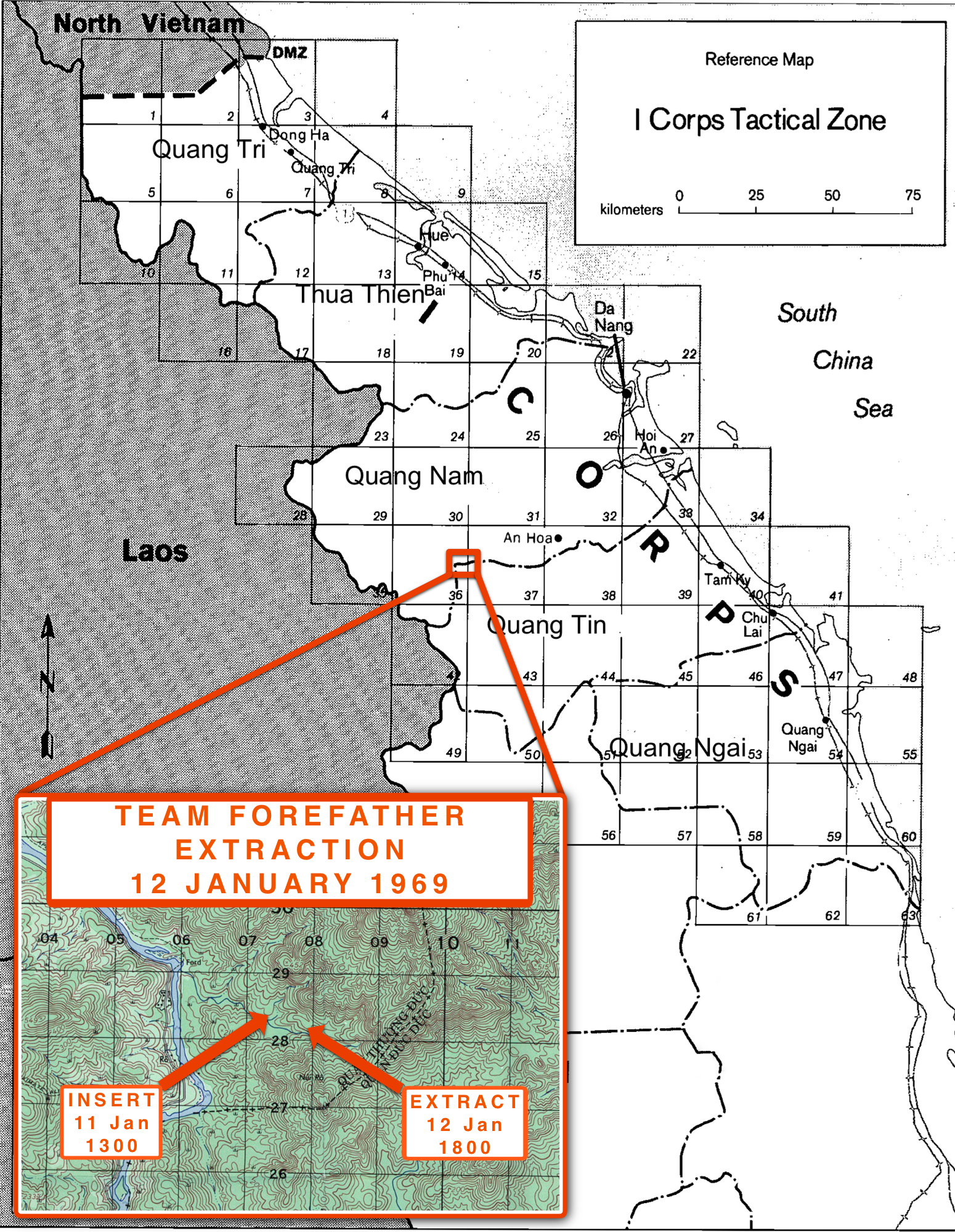
Less than one hour into the patrol, Forefather had already made contact.
Thompson squeezed the trigger and dropped the NVA soldier. The rest of the Marines opened up, killing two more. The remaining three fled down the trail. Thompson grabbed his radio handset. “Night Scholar, this is Forefather Six. We are in contact. Do you copy?” No response came from the COC. He tried again. No comms. They needed to contact An Hoa and to do that they needed higher ground. The team melted into the forest away from the trail. They moved 200 meters farther up the hill behind them. From their new position, Thompson established degraded comms with Lt Finlayson.
It was now after 3 p.m. and the sun dipped near the top of the mountains. The Marines had not seen or heard anything since their initial firefight on the trail. Thompson decided to remain in the current position for the night and the Marines spread out in a defensive perimeter. As darkness fell, those not on watch tried to doze off, but no one slept. “Forefather Six, Forefather Six, what’s your status?” The watch officer at the COC checked in to make sure the team had not been wiped out. Thompson clicked once on his handset’s talk button. This silently signaled back that all was okay. No one talked. No one moved. Everyone prayed for daylight.
Night finally turned to daylight, and the Marines prepared to move out. As they ate breakfast, checked their weapons, and reapplied paint to camouflage their faces, Thompson was again stopped by a feeling. Normal procedure would be to move out at dawn, but this morning, something was off. The jungle felt too quiet. Sometime during the night, the team had again lost comms with the COC. “That was the first time ever, with any team, I didn’t move out right away,” remembered Thompson. “Something wasn’t right, we just knew it, so we stayed there.”
The team returned to their perimeter. Thompson hoped they would soon see a Cessna Bird Dog overhead. These tiny, single-engine aircraft were used by forward air controllers, but could function as a radio relay and help him re-establish comms with the COC. Forefather waited in their position for several hours. Finally, around 11 a.m., a Bird Dog came into view. Thompson reached the airplane on his radio, which relayed his position. Finlayson told Thompson to resume his mission and move out.
The team picked up and moved toward their original objective. After an hour trekking through thick undergrowth, they emerged into a clearing under the jungle canopy. The point man halted the patrol and crouched down. Walking at an angle to their front, at least 20 NVA soldiers moved in unison, spaced apart on line. They traveled fast and light with AK-47s, but carried no packs or even canteens, conducting an anti-recon sweep to flush out Forefather. Both sides realized the others’ presence at nearly the same instant. NVA soldiers nearest the Marines opened up and the Marines returned fire, killing one. They poured fire at the enemy long enough to make the NVA scatter, then the Marines ran. Going toe-to-toe in the jungle with a force more than twice their size was not a good idea. Thompson and the others broke contact and headed up the hill to higher ground.
The team reached the crest of a knoll around 200 meters from where they made contact. They looked out in frustration as they came to an abrupt halt. A massive bomb crater—big enough to hold a house—cut off their escape. Thompson knew entering the crater with the enemy close behind would make them like fish in a bowl for the NVA. They were stuck, with the enemy closing in from three directions, and the crater blocking the fourth.
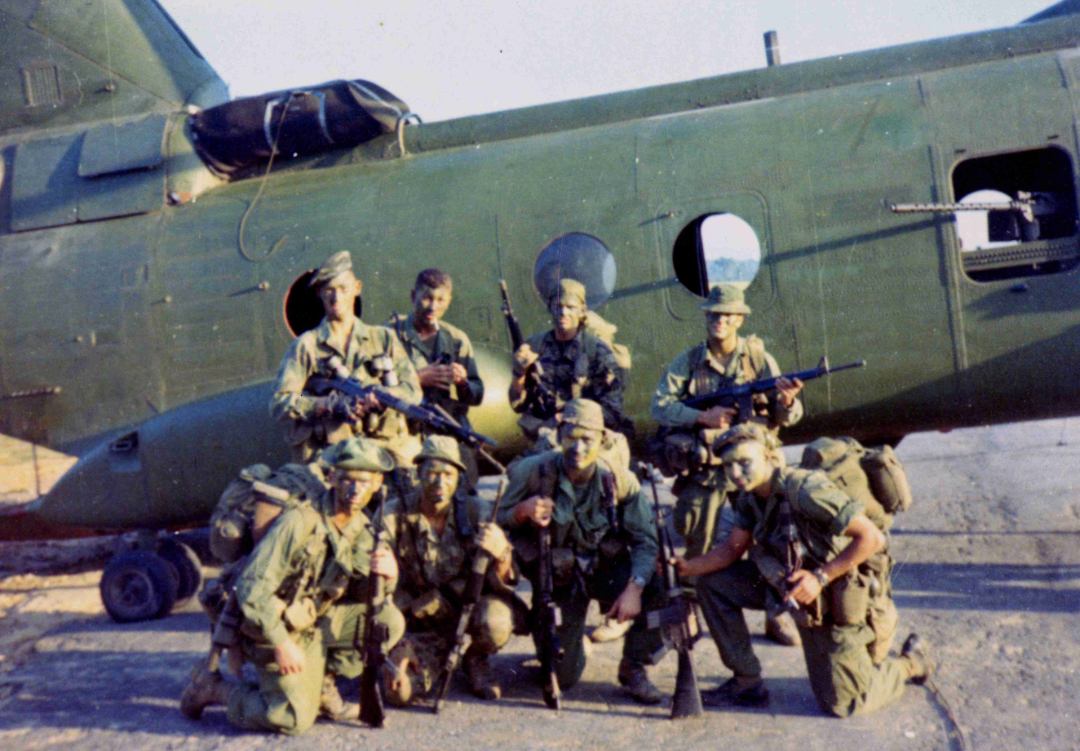
Thompson arranged his defense with the team and raised the COC on his radio. “Night Scholar, this is Forefather Six. We are in contact, request emergency extraction.” Upon learning the situation, Lt Finlayson forwarded the request for extraction up the chain of command. He immediately called for support from UH-1N Huey gunships and fixed-wing jets.
Thompson and his men heard the enemy all around. The sounds crept closer and closer until suddenly, an enemy soldier popped his head out from the brush 5 feet away. The closest Marine blasted him in the face and continued firing. The ensuing firefight resulted in three more enemy killed before they retreated. The Marines loaded fresh magazines and waited for the next contact. They had been in their position for more than an hour already. The sound of aircraft overhead finally sang in Thompson’s ears. He made contact with the Bird Dog, who relayed the team’s position and coordinated the operation. Jets screamed in, pummeling the jungle floor with their bombs. UH-1N Huey gunships followed with rockets and machine guns.
Despite the air support, Forefather continued fighting off the enemy on their own on the ground. Magazine after magazine fed through their M16s. Thompson, focusing on the radio, handed out his own ammunition as other Marines ran dry. Four more hours passed, and the sun began to set. Thompson knew if they did not get out, this night would not go as well as the last.
Approval for extract finally arrived. Finlayson’s voice came over the radio. “Forefather Six, this is Night Scholar Three, emergency extract is in route. Need you to move north toward alternate LZ, over.” Thompson looked north behind him at the bomb crater. “Negative Night Scholar, moving north not possible,” he replied. He tried to make their perilous situation clear, but it didn’t seem to sink in. “Roger Forefather Six, then need you to head west and cut back ASAP,” came the reply. Thompson’s frustration boiled over. “Night Scholar, I can’t go north. I can’t go south. I can’t go east. I can’t go west. I can’t move without losing the team! Either try to get someone in here to get us out, or send body bags in the morning!”
Back at An Hoa, Sgt Buda was conduct-ing a rapelling class. He stood atop the rappel tower when he saw a Marine sprint-ing toward them. “Sgt Buda!” the Marine yelled up, “Maj Simmons needs to see you, now. There’s a problem and they need your help!” Buda rapelled down and ran to the COC. Maj Simmons brought him up to speed on Forefather’s situation. He told Buda a CH-46 was going to get them, and he wanted Buda to ride along. His knowledge of the terrain could help the pilot get over the team faster, and his experience with the jungle penetrator would hopefully speed up that process as well. The helicopter stopped at An Hoa, picked up Buda, and headed toward Forefather.
Enemy soldiers had massed around the team as the afternoon hours passed. They moved farther up the hill above the Marines and waited for the helicopters they knew would come. They reached an elevation that a rescue chopper could reach and hover over the Marines. From this position, the NVA could shoot directly, or even down, at any aircraft going after the team.
Buda guided the pilot over the area where Forefather held its ground. At 2,000 feet, the CH-46 circled as Huey gunships swooped down and unloaded their awe-inspiring display of firepower. Buda looked on, knowing precisely how the gunships meant life or death for the team. Thompson heard bullets smacking trees and leaves like a heavy rain. The gunships closed in, and the sound turned to dull thuds as the rounds impacted the ground. Marines saw miniature explosions in the dirt, one after another in rapid succession, moving straight for them. The helicopters ceased firing with seconds to spare, stopping the stream of bullets less than 20 meters in front of Forefather’s position. A UH-1N Huey pulled up and roared over Thompson’s head. The next chopper repeated the gun run, and completed another after that. Nearly an hour passed before the CH-46 dropped in to attempt the hoist.
The helicopter came under fire before it even established a hover. The pilot held steady as Buda dropped the jungle penetrator through the floor. Lying on his stomach, watching the hoist descend, Buda felt a warm rain begin pouring through his hair and down his neck. He looked up to see hydraulic fluid spraying from a destroyed line. He watched streams of daylight appear through new bullet holes in the wall and debris flew
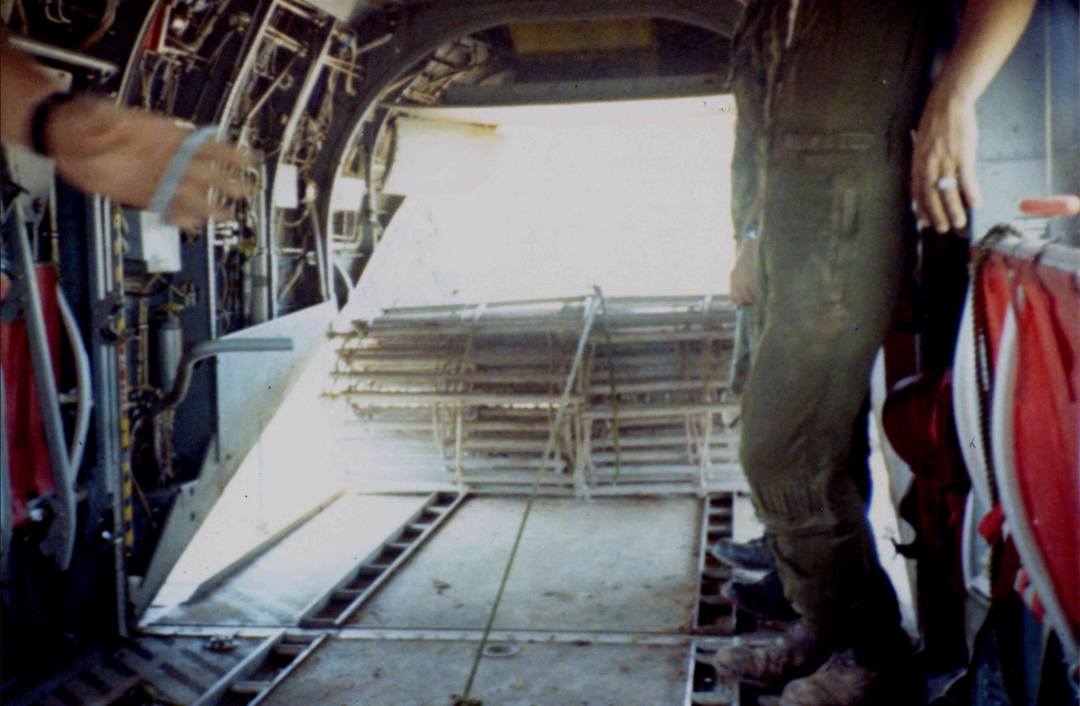
off as the rounds impacted the far side. In the cockpit, he witnessed every light on the control panel light up like a Christmas tree. “It’s coming apart,” he thought to himself. Over the intercom, the pilot ordered the crew chief to blow the line and drop the hoist. They had to get out of the zone. Thompson watched the chopper struggle to remain airborne. He saw the jungle penetrator fall away to the ground as the helicopter groaned and lifted higher. He knew they would have to hold on for a while longer.
The helicopter limped through the sky, miraculously making it 20 minutes back to An Hoa, where the pilot made a hard landing. As the chopper hit the ground, one of the rear rotor blades flew off. Buda jumped off, drenched in sweat and hydraulic fluid, but otherwise unscathed. He wondered what would happen now.
Lt Finlayson discussed the situation with Maj Simmons. They were running out of options for Forefather. Another try with the jungle penetrator would only produce the same results, or worse. “Sir, the ladder. We’ve got to give it a shot,” said Finlayson. Simmons agreed. It was their only other viable option. Finlayson sought out Buda as he watched others counting holes in the downed chopper. “Buda, get the Simmons Rig together. We’re trying it this time,” he said. Buda departed to prepare the rig, and Finlayson radioed for another chopper.
Capt Adams had just returned to his home airfield at Da Nang. It was around 4:30 p.m. He had logged more than eight hours flying time by that point, running resupply missions all day. He entered the squadron headquarters when the call came down from An Hoa for another recon extraction. Despite his exhaustion from the day, Adams volunteered to go. The 25-year-old pilot participated in many recon inserts or extracts. For his role extracting Lt Slater and his team the previous December, Adams was awarded the Silver Star. His fellow pilots nicknamed him “Blades” in honor of the exceptional number of rotor blades he damaged tucking his chopper into tight LZs between trees. Adams possessed experience and knowledge of the jungle penetrator, but had never seen or even heard of the ladder.
Sgt Buda moved the Simmons Rig into the LZ at An Hoa as Adams landed and started refueling. “What’s this?” Adams asked. “It’s a ladder, sir,” replied Buda. “We’ve been trying to get these guys out all day, but nothing’s working.” He explained how the ladder worked, and that he would come along to help. Adams told him to put it on the chopper and they would give it a try. Buda set up the rig and positioned the ladder on the tail. Adams lifted off with his crew and Buda around 5:30 p.m. The sun sank low behind the dark clouds of an approaching storm.
Adams approached the area and he circled at 1,500 feet. Gunships again strafed the jungle surrounding Forefather and the remaining jets dropped the last of their ordnance. As the other aircraft pulled out, Adams dropped his bird 80 feet above the team. The enemy on the hillside opened up on the hovering helicopter. Buda unhooked the ladder and kicked it over the tail. Adams’ crew chief, Corporal James Tyler, dropped prone on the tail ramp looking down over the unraveling ladder. Through his headset, he expertly directed Adams until the bottom of the ladder touched the ground close to the Marines. He told the pilot to stop, but the chopper kept moving. Tyler yelled louder into his headset, but the ladder continued in the wrong direction. He turned and realized a bullet had severed his communication line. Tyler stood and ran through the helicopter to the cockpit. He shouted commands directly into Adams’ ear over the din of the engines and gunfire. Tyler returned to the tail ramp through a hail of bullets to watch the ladder. Once corrected, he gave a thumbs-up to the copilot, who communicated to Adams to hold the chopper steady.
For the first time in six hours, the recon team left its defensive position and sprinted toward the ladder. Thompson grabbed ahold with his left hand and used his right to assist the others. Two Marines climbed 12 feet up the ladder making room for the rest to follow. Thompson noticed one of his Marines behind the rest of the patrol, slowly making his way toward the ladder. “Hey, what the hell are you doing? Let’s go!” Thompson shouted. “I can’t find my snap link!” the Marine replied. This vital piece of equipment attached the Marines to any extraction device, ensuring they would not fall. Thompson yelled at the Marine to find it and hurry up as he helped two more Marines scale the ladder. The fifth Marine began his ascent. Thompson looked back again and saw the lagging Marine now going through his pack in search of the snap link.
“Get up here now!” he yelled again, “We have to go, LET’S MOVE!!”
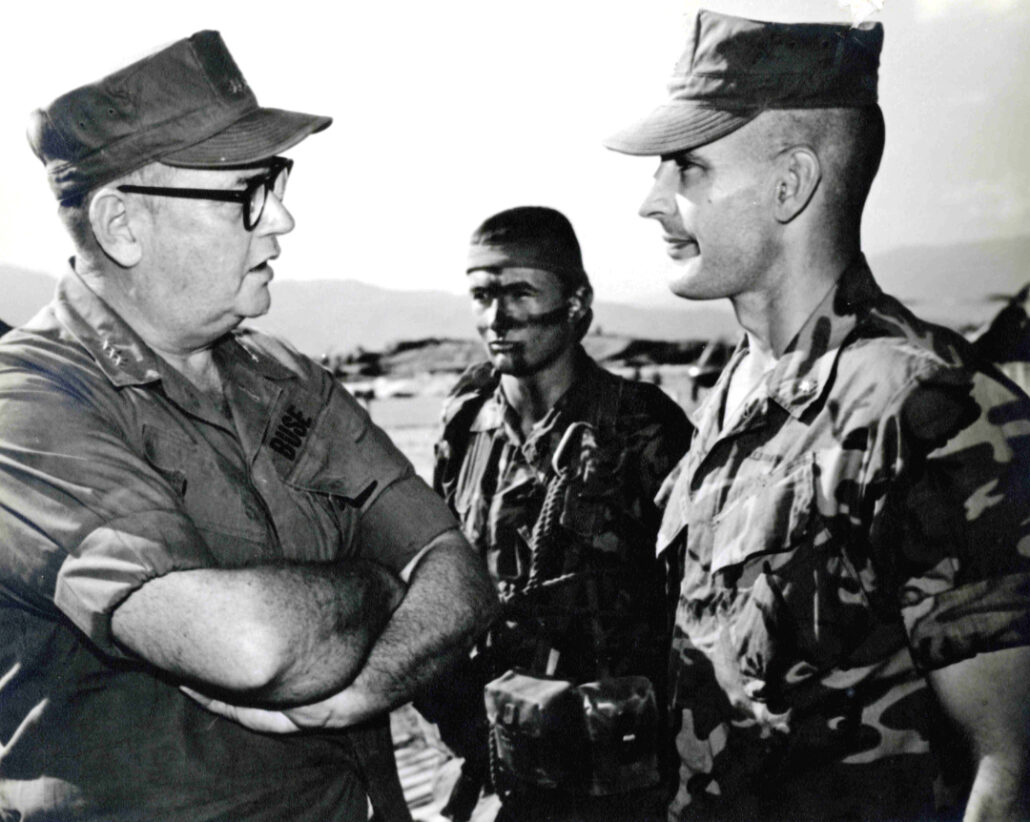
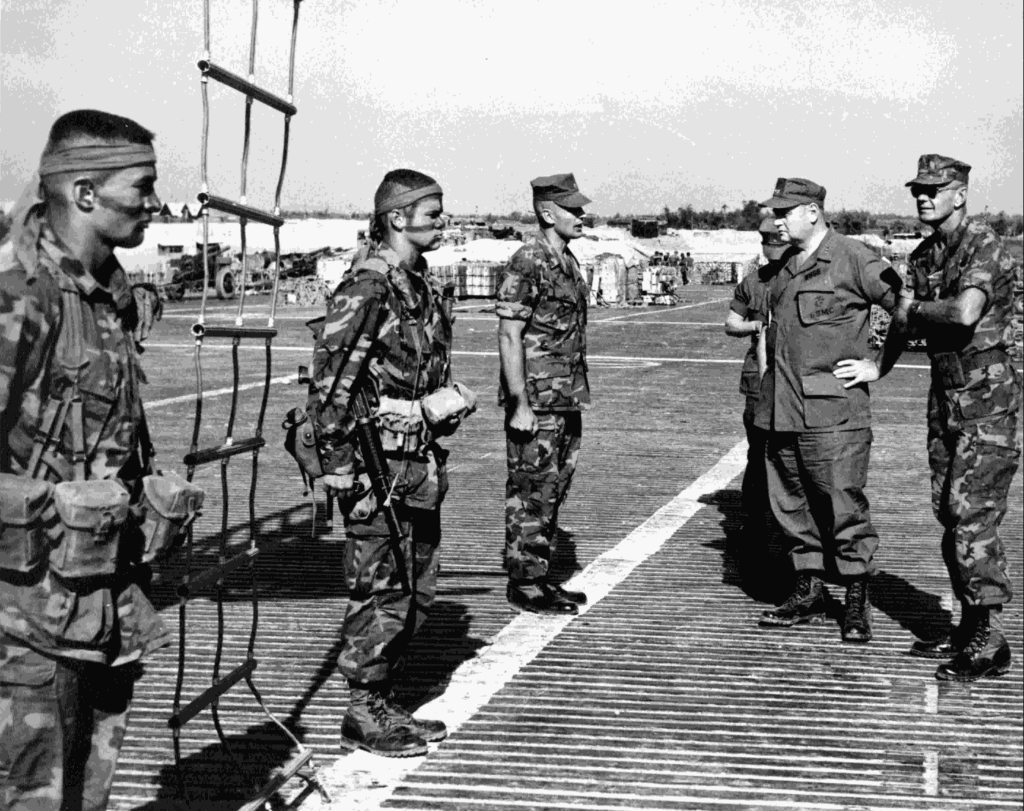
Overhead, Adams fought the helicopter to keep it steady. The added weight of the Marines underneath proved challenging, and enemy rounds chipped away all over the helicopter. Gunfire mixed with the whine of the helicopter in a deafening roar. In the background through his headset, he heard his crew shouting. They were only overhead for a few minutes, but it quickly turned into a very bad situation. From the tail ramp, Tyler signaled to the copilot that five Marines were on the ladder. “Five on board, we’ve got five on,” Adams heard someone say. “Roger, five on. Let’s go,” he replied. No one told him how many Marines were on the ground.
Thompson felt the ladder pulling upwards out of his hand. His knuckles went white, willing the helicopter to stay. He looked at his radioman and the other Marine still on the ground. He knew he could not leave them. Thompson let go and hustled the others away as the ladder ascended. Run ning down the hill, he grabbed the radio and yelled to anyone listening. “We’re still down here! Three still on the ground!” His primary concern was that a gunship or jet might drop something on top of them, thinking the whole team was off the ground. The Bird Dog overhead responded he knew the Marines remained.
The remaining three ran until the heavy thud of their footsteps became louder than the fading helicopters and formed a tight triangle in the thickest brush they could find. In the sudden silence, Thompson realized his rapid breathing was the loudest thing in the jungle. The enemy obviously believed the entire patrol had been extracted. The Marines remained frozen and waited, hoping someone would find them before the NVA did.
Adams gained altitude with the five recon Marines hanging beneath the heli copter. As they rose to safety, the Bird Dog pilot’s voice came through relaying the news that three Marines were still on the ground. A sinking feeling grew in the pit of Adams’ stomach as he thought through the situation. He looked down at his controls. The stick felt good in his hands, and the helicopter readily responded to his commands despite the damage. He knew as long as the chopper could function, he could not leave the Marines behind. He made up his mind they would go back.
They located a forward artillery base on a secure hilltop less than 6 miles from the extraction site. Rather than making the 20-minute flight back to An Hoa, Adams elected to drop the recon Marines there. He arrived over the hilltop and lowered the helicopter carefully. Tyler directed from the tail and, without landing, gently let the five Marines down. Once they unhooked, Tyler gave the thumbs up and Adams turned back with the ladder fully extended beneath the bird.
The sun was gone and rain clouds further obscured any remaining light. Adams knew this was his last chance to get the Marines out before it was completely dark. The jets had expended all their ordnance and were gone. The gunships had also ran their guns and rockets dry. Adams would have to make the final rescue attempt on his own.
He dropped the chopper below 1,500 feet as he approached the zone. Tracer rounds arched skyward through the twilight as he descended. Before he could get into position over the Marines, the helicopter was already taking more hits from intense enemy fire. Adams yanked the chopper back into the air out of small arms range. He circled around and tried coming in from a different direction, yielding the same result. Adams knew that dropping down on top of the zone made him too much of a target and left him exposed for too long. He needed a different approach—a small stream ran up the valley at the base of the mountain.
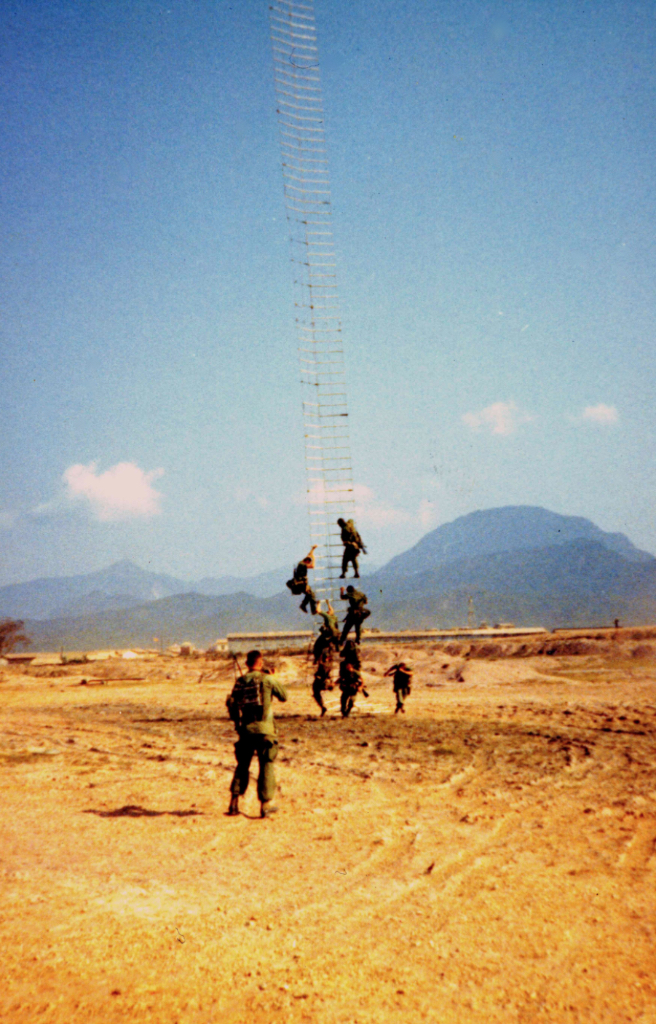
Adams circled back for a third approach, this time continuing farther down the valley. He dropped the helicopter low and gunned the engines. The ladder whipped in the wind, standing out behind the chopper as it accelerated towards the Marines. When he neared the zone, Adams popped up 100 feet above the ground and the ladder dropped back vertical. As the enemy fire resumed, he swung the tail end around into the fire. The rear armor plating and smaller target profile facing the enemy gave the helicopter its best hope.
Thompson watched the chopper thunder overhead. The helicopter stopped in exact-ly the same spot it had been 20 minutes earlier. The ladder touched the ground and began moving in the Marines’ direction. As they moved back up the hill, Thompson noticed a tall bombed-out tree stump directly in the path of the ladder. His heart sank as images flashed in his vision of the ladder getting stuck and the struggling chopper coming down. The ladder eased against the stump, then up and over the top. As it dropped mercifully down the other side, Thompson and the others came sprinting.
Enemy fire raked the helicopter as Adams fought to keep it steady. Buda manned a door gun, blasting away at the enemy below. As he returned fire, he felt a punch in his left thigh. He looked down and saw a growing circle of blood staining his utilities. Adrenalin coursing through him shielded him from pain as he kept firing. Tyler positioned himself back on the tail ramp to direct Adams over the remaining Marines. He stood motioning to the copilot when a bullet entered his right leg below the buttocks. The round dropped him back to the deck, but he continued his commands to perfectly position the helicopter.
The Marines finally reached the bottom of the ladder. Enemy surrounded the area, but all fire focused on the chopper overhead. The radioman started climbing. Thompson looked back at the last Marine. “I never found my snap link!” the Marine shouted. “Then you’d better hold on!!” Thompson replied. The Marine stuck his arms and legs through the ladder, clinging with all four appendages. Thompson snapped on underneath of him. The last member of Forefather was finally off the ground.
Adams heard through the chaos that everyone made it onto the ladder. For a final time, he lifted above the jungle. Below the chopper, Thompson closed his eyes as rain began pelting his face. A final feeling overpowered his senses. They made it.
Adams lowered the ladder to the ground back at An Hoa. Thompson unhooked and immediately searched for the rest of his team. Lt Finlayson grabbed him and told him about the forward artillery base where Adams dropped the other five members of Forefather. The three Marines were whisked away for debriefing. By the time Adams landed, Thompson and the others were gone. He would never meet the eight Marines they rescued that day.
As others slapped his back, shook his hands, and offered him steaks, Adams surveyed his damaged helicopter. More than 100 holes
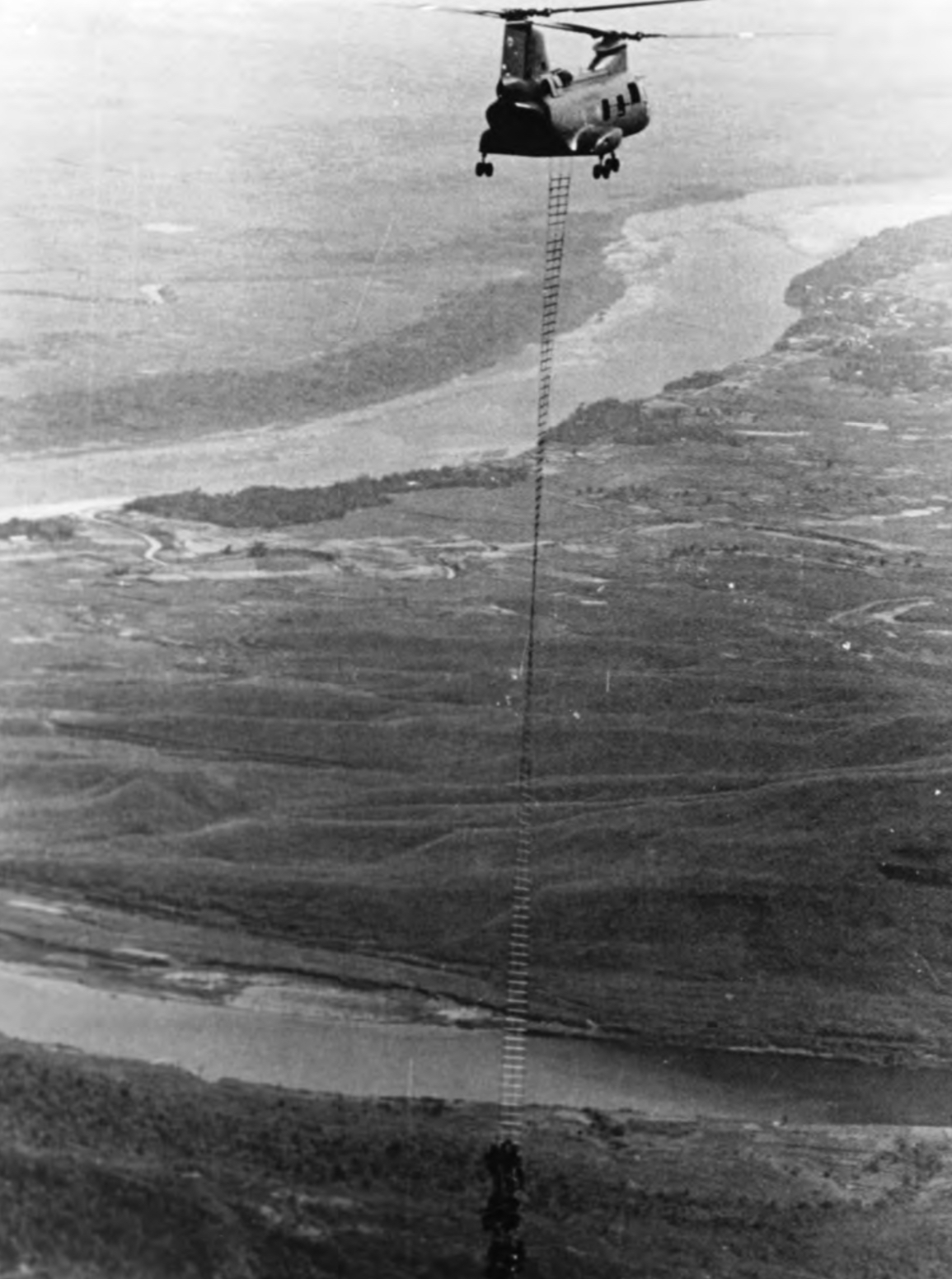
were later counted. “I think it just wasn’t my time,” Adams reflected recently. “I think it was just time to rescue those guys, and maybe it wasn’t their time either.” A Huey picked up Adams and his crew and returned them back to Da Nang.
After two helicopters and three rescue attempts, Sgt Buda finally made it back to An Hoa, where he awaited medical treat ment. He lay outside looking on as others gawked at the beaten and destroyed helicopters that had been his rides over the zone. “What happened to you?” the doctor asked when Buda’s turn came. “Well Doc, I tripped over an ammo can. I might need a stitch,” Buda replied. The doctor removed the pant leg and began probing around in the wound. A few seconds later, the forceps emerged holding a bloody AK47 bullet. “An ammo can, huh, Sarge?” said the doctor, dropping the round into a pan. “I’ve heard that be fore. You see this tag? This guarantees you’re going to the hospital for follow up. There’s no way we’re going to ignore this.” The following day, Buda was evacuated to a hospital in Japan. There he received his third Purple Heart. Once recovered, he flew to Okinawa, then to Kaneohe Bay, Hawaii. He would not return to Vietnam.
This first use of the Simmons Rig in combat proved a turning point for recon emergency extractions. The success demonstrated the ladder’s capability as combatworthy tool. It also stood out as a stunning example of the heroics required for missions of this type. Sgt Buda and Cpl Tyler each received a Purple Heart for the wounds they sustained in the helicopter. Tyler also received a Silver Star for his actions directing Adams over the team. Sgt Thompson was also awarded the Silver Star for leading the team on the ground and for his decision to remain behind. For his heroic flying, warrior spirit, and refusal to leave any Marines on the ground, Capt Adams was awarded the Navy Cross.
First Force Recon utilized the Simmons Rig more frequently as 1969 progressed, replacing the jungle penetrator on numerous occasions. It was a great tool, but its flaws haunted the unit. Not long after the successful extraction of Forefather, another patrol met disaster. Being extracted from the banks of a stream, six recon Marines snapped onto the ladder. The pilot took off, but with the weight of the team under the chopper, he struggled to gain altitude. The helicopter dragged the ladder and Marines into the stream. After more than a minute under the water, dragging across the rocky bottom, two of the Marines were knocked off and drowned.
Insertion and extraction techniques continued progressing, and the STABO harness eclipsed the Simmons Rig as the preferred method. This was further improved into the Special Patrol Insertion and Extraction (SPIE) rig, which is still used today.
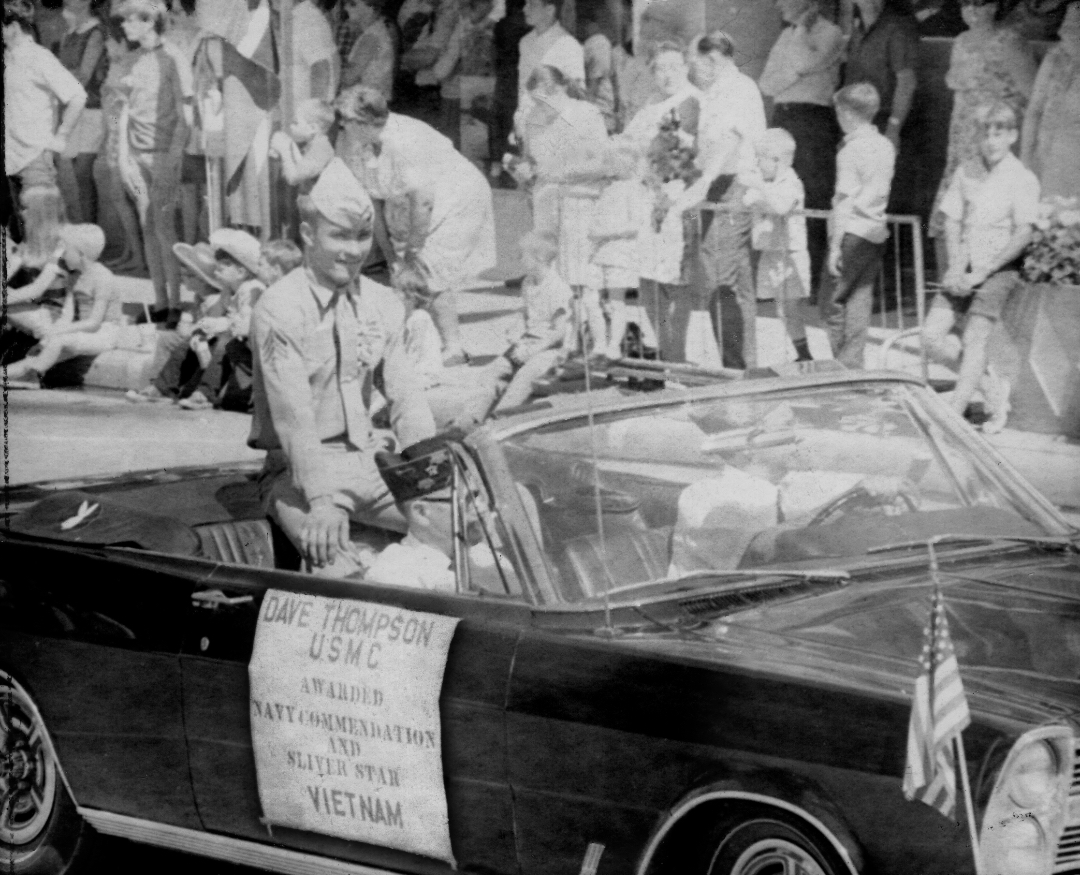
Larry Adams, Bob Buda, and Dave Thompson all left Vietnam and the Marine Corps shortly after the mission. Adams returned to the states as a flight instructor in North Carolina. He was surprised and disappointed by the nation’s indifference and politically motivated attacks on servicemembers. He discovered that while he was gone, two college friends attempted to take out a life insurance policy on him, figuring they could cash in when he didn’t return. Adams flew more than 1,000 missions in 600 flight hours in Vietnam, earning 50 Air Medals and two Distinguished Flying Crosses in addition to his Silver Star and Navy Cross. He married his sweetheart and settled in Washington, where he worked in the radio industry and became a successful entrepreneur.
After his recovery at Kaneohe Bay, Buda was presented with orders to be an instructor at Amphibious Reconnaissance Course in Coronado, Calif. Rather than accepting this dream job for any recon Marine, he opted to get out. Back now from Vietnam, Buda witnessed a side of the Marine Corps that disturbed him deeply. Race riots broke out on Marine bases across the nation, with one of the worst happening in Kaneohe Bay. “It was absolutely terrible,” remembered Buda. “It was a terrible time to be in the Marine Corps. I thought we were going to hell in a handbasket, and I didn’t want to be part of it.” Buda left the Marine Corps and joined the Honolulu Police Department and began life outside the military. He moved to the mainland where he continued as a police officer and detective in California for the rest of his career. He is now retired and living in Illinois.
Thompson returned home to orders as a drill instructor (DI) in San Diego. With only six months left on his contract, the Corps decided not to train him as a DI. Since they couldn’t send him back to Vietnam, they let him out early. Three and a half years after enlisting, Thompson returned to his home state of Wisconsin as a civilian. Two months after leaving the Marines, he found out he had been awarded the Silver Star in addition to a Navy Commendation with combat “V.” He donned his dress uniform for one final time as the governor of Wisconsin pinned the medal on his chest, followed by an Independence Day parade where he was honored as one of the main features. Thompson worked in manufacturing for many years, and finished off his career with the United States Department of Agriculture. He is now retired and living in his hometown.
Often, veterans like Adams, Buda, and Thompson discuss their experiences of 49 years ago with reverence and reluctance. The selfless examples of courage, humility, and dedication that many veterans have set throughout their lives serve as a continuation of their service to their communities and our country.
“At the end of the day, you’re called, and you go,” reflected Adams. “You don’t think about the political implications. You just go and do your job. There’s no great glory to that, there’s just a job that needs to be done. You find out what you need to do, and go ahead and do it. And by the grace of God, you’ll come out of it OK.”
Author’s note: To Dave Thompson, Bob Buda, and Larry Adams, thank you for reliving your incredible stories with me and allowing me to tell them. I hope these words can justly honor your service to each other and our beloved Corps. To all the Marines of 1st Force Recon and HMM-165 involved that day, and so many others, Semper Fidelis.
This Article was originally published in the April 2018 Leatherneck Magazine.
About the Author

Kyle Watts is the staff writer for Leatherneck. He served on active duty in the Marine Corps as a communications officer from 2009-13. He lives in Richmond, Va., with his wife and three children. In 2019, the Marine Corps Heritage Foundation awarded him the Colonel Robert Debs Heinl Jr. Award for Marine Corps History for this story.


